Java Sophos Utm Api Example
Two-Factor Authentication (2FA/MFA) for Sophos UTM
Sophos UTM offers advanced next-gen cloud sandboxing technology that provides a whole new level of ransomware and targeted attack protection, visibility, and analysis. Miniorange works with Sophos UTM VPN to provide an additional layer of authentication and protection for administrators and end-users that access Sophos VPN and firewall.
After setting up your own Sophos UTM SSL VPN, you may want to enhance its security. One way to do that is to enable Multi-Factor Authentication (MFA) for Sophos VPN. To boost security, activate Two-Factor Authentication (2FA) for your Sophos VPN Managed AD directory. When you enable 2FA, your users must provide their username and password (first factor) as usual, as well as an authentication code based on your configured 2FA method to gain access to Sophos UTM SSL VPN.
As a second factor, miniOrange offers 15+ MFA methods to choose from, such as Google/Microsoft/Authy Authenticator, Push Notifications via the in-house miniOrange Authenticator app, OTP via SMS/Email, and many more.
Types of 2FA Authentication with RADIUS
Depending on the VPN client, 2-factor authentication can take two forms..
- VPN Clients that support RADIUS Challenge.
- VPN Clients that do not support RADIUS Challenge.
miniOrange 2FA authentication for Sophos UTM Login
miniOrange accomplishes this by acting as a RADIUS server that accepts the username/password of the user entered as a RADIUS request and validates the user against the user store as Active Directory (AD). After the first level of authentication, miniOrange prompts the user with 2-factor authentication and either grants/revokes access based on the input by the user.
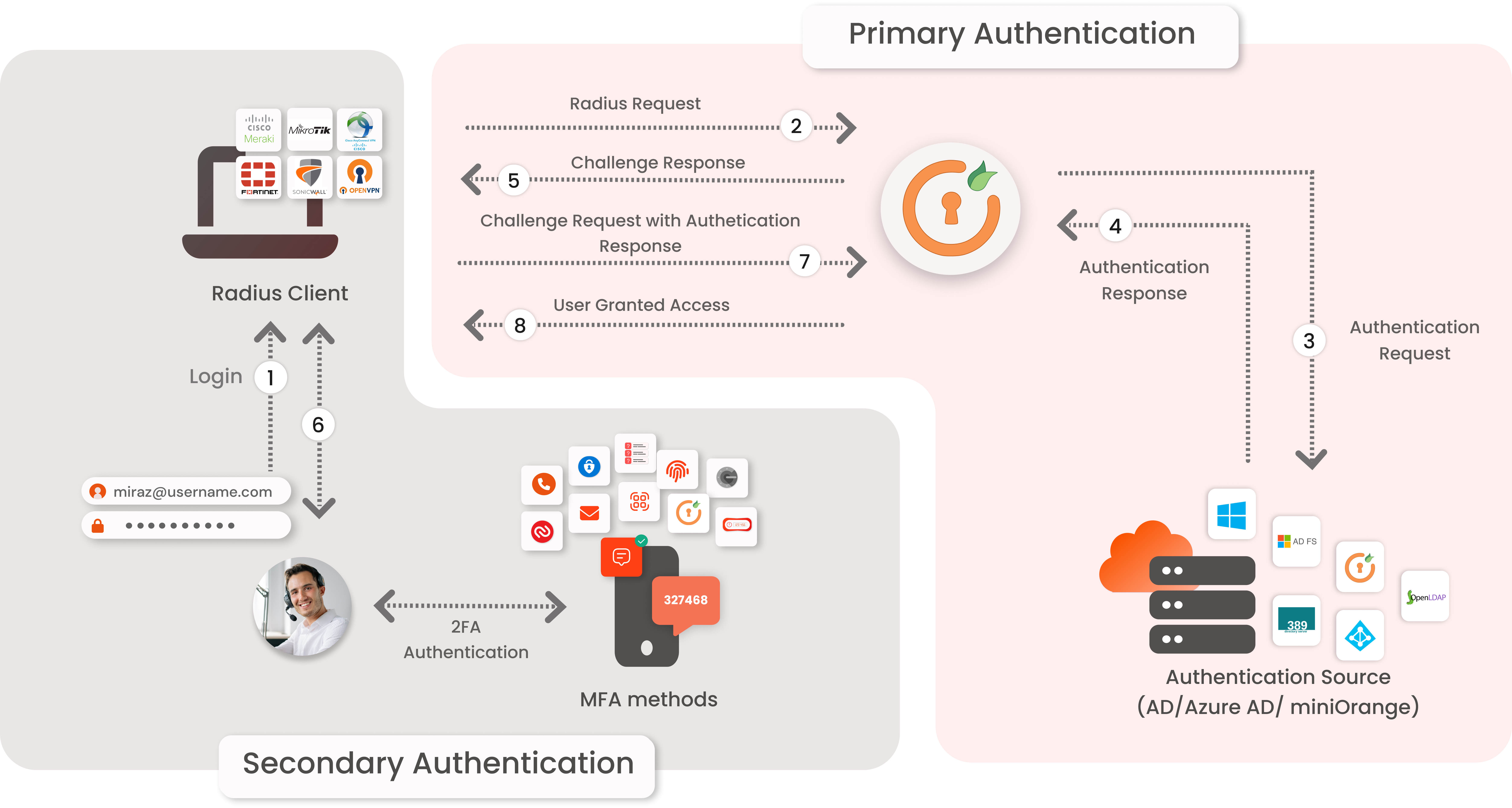
- Primary authentication initiates with the user submitting his Username and Password for Sophos UTM.
- User request acts as an authentication request to RADIUS Server(miniOrange).
- miniOrange RADIUS server passes user credentials to validate against the credentials stored in AD (Active Directory) / Database.
- Once the user's first level of authentication gets validated AD sends the confirmation to RADIUS Server.
- Now miniOrange RADIUS Server asks for a 2-factor authentication challenge to the user.
- Here user submits the response/code which he receives on his hardware/phone.
- User response is checked at miniOrange's RADIUS Server side.
- On successful 2nd factor authentication the user is granted access to login.
What are different 2FA/MFA methods for Sophos UTM supported by miniOrange?
miniOrange supports multiple 2FA/MFA authentication methods for Sophos UTM secure access such as, Push Notification, Soft Token, Microsoft / Google Authenticator etc.
| Authentication Type | Method | Supported |
|---|---|---|
| miniOrange Authenticator | Soft Token | |
| miniOrange Push Notification | ||
| Mobile Token | Google Authenticator | |
| Microsoft Authenticator | ||
| Authy Authenticator | ||
| SMS | OTP Over SMS | |
| SMS with Link | ||
| OTP Over Email | ||
| Email with Link | ||
| Call Verification | OTP Over Call | |
| Hardware Token | Yubikey Hardware Token | |
| Display Hardware Token |
You can opt for any of the 2FA methods to secure your Sophos UTM. To integrate 2FA, you can enable RADIUS authentication in Sophos UTM and configure policies in miniOrange to enable or disable 2FA for users.
Connect with any External Directories
miniOrange provides user authentication from various external directories such as miniOrange Directory, Microsoft AD, Azure Active Directory/LDAP, AWS Cognito and many more.
Can't find your Directory? Contact us on idpsupport@xecurify.com
Get Free Installation Help - Book a Slot
miniOrange offers free help through a consultation call with our System Engineers to Install or Setup Two-Factor Authentication for Sophos UTM solution in your environment with 30-day trial.
For this, you need to just send us an email at idpsupport@xecurify.com to book a slot and we'll help you setting it up in no time.
Enable Two-Factor Authentication (2FA)/MFA for Sophos UTM Client to extend security level.
1. Add the Radius Client in miniOrange
- Login into miniOrange Admin Console.
- Click on Customization in the left menu of the dashboard.
- In Basic Settings, set the Organization Name as the custom_domain name.
- Click Save. Once that is set, the branded login URL would be of the format https://<custom_domain>.xecurify.com/moas/login
- Go to Apps Click on Add Application button.
- Choose RADIUS as Application type and click on Create App button.
- Click on Sophos UTM application tab. If you don't find your application click on Radius Client application tab.
- Configure the below details to add Radius Client.
- You can refer the table below for Vendor group attributes id.
Vendor Name Group Attribute Vendor ID Vendor Attribute ID Cisco ASA VPN 26 Vendor-Specific 3076 25 Fortinet VPN 26 Vendor-Specific 12356 1 Palo Alto VPN 26 Vendor-Specific 25461 5 SonicWall VPN 26 Vendor-Specific 8741 3 Citrix VPN 26 Vendor-Specific 66 16 - Configure the following Policy details for the Radius Client.
- After configuring the given above details, Click on Save button.
- Copy and save the Radius server IPs which will be required to configure your Radius client.
- In order to receive the RADIUS request, it is necessary to open UDP traffic on ports 1812 and 1813 for the machine where On-Premise IdP is deployed.
- If the hosting machine is a Windows Machine then you can follow this document.
- If the hosting machine is a Linux Machine then you can follow this document.
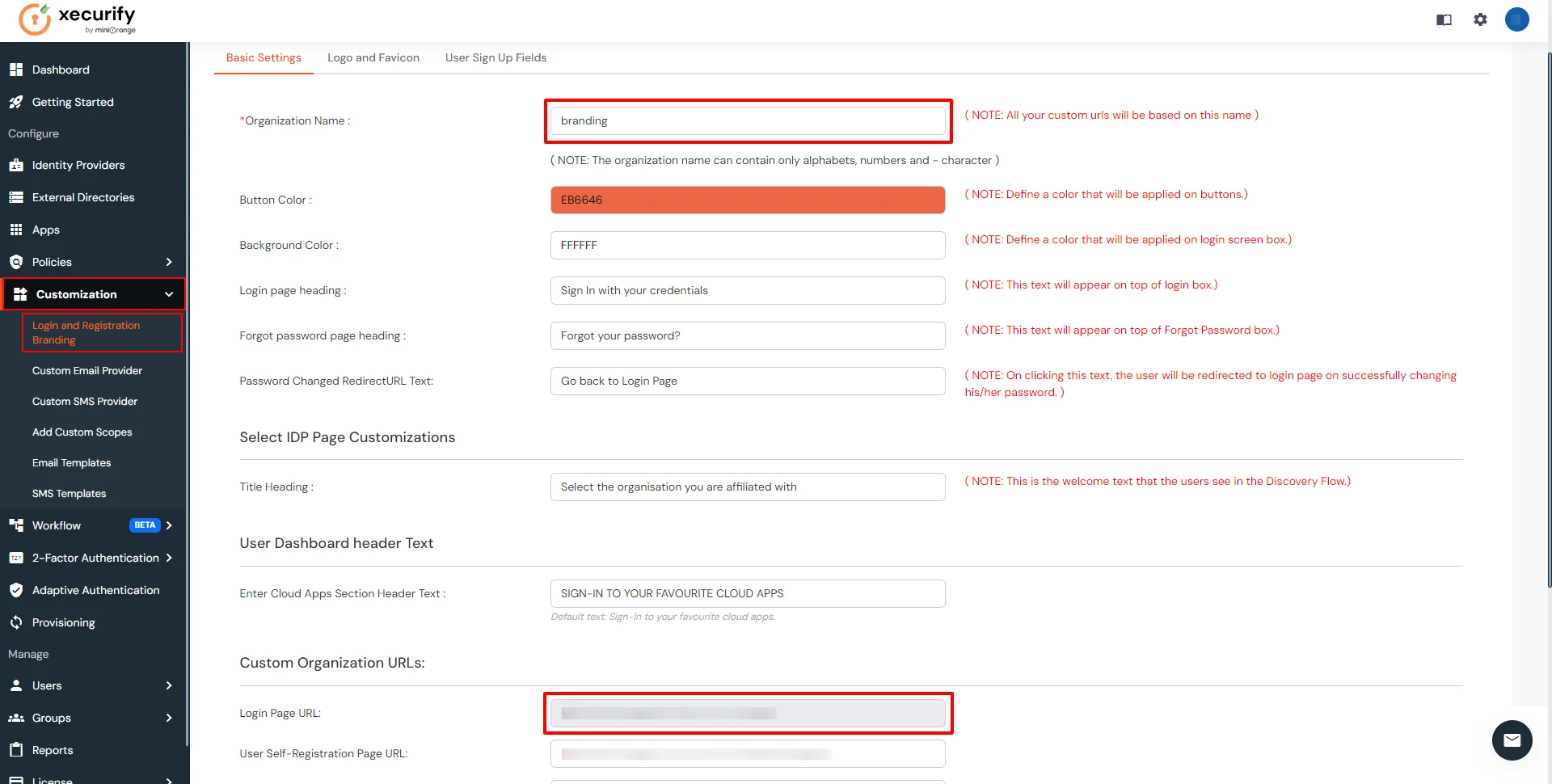

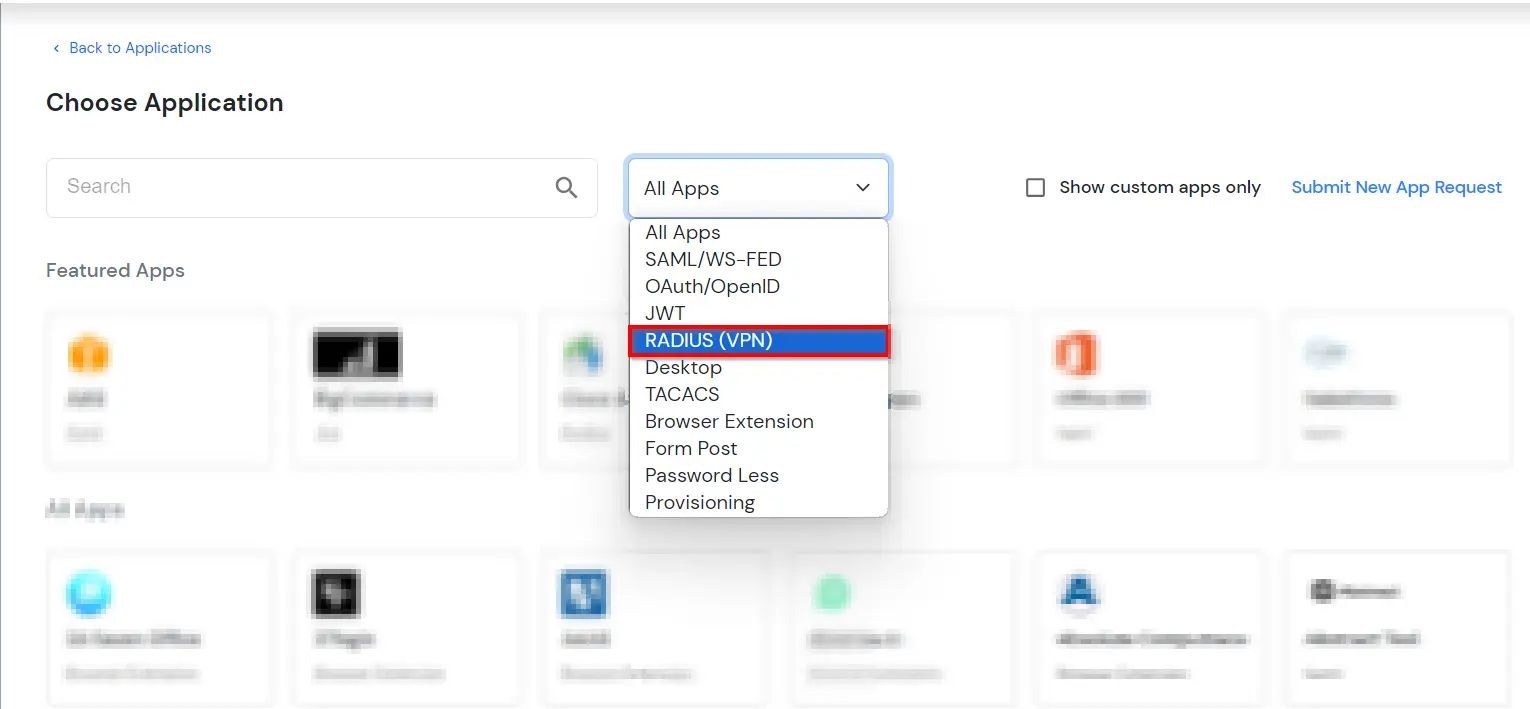
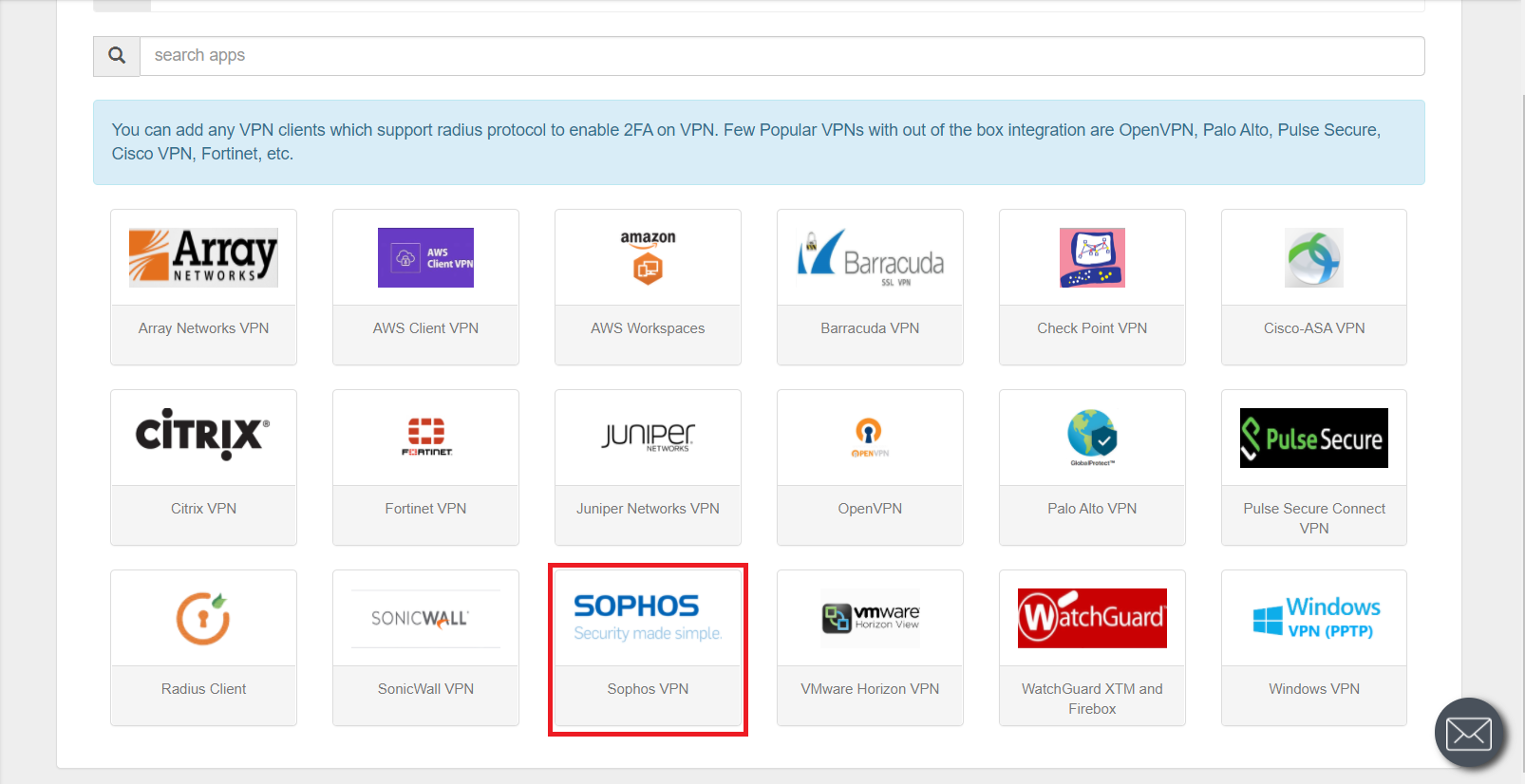
| Client Name: | Any name for your reference. |
| Client IP: | IP address of VPN server which will send Radius authentication request. |
| Shared Secret: | Security key. For Eg. "sharedsecret" (Keep this with you, you will need to configure same on VPN Server). |
| Include Password & OTP in same Request | Check this option for clients which takes password and the OTP in same request. Otherwise keep it unchecked. |
| Send Groups in Response | Enable this to send user groups as Vendor-Specific Group Attributes. |
| Group Name: | Group for which the policy will apply. |
| Policy Name: | Any Identifier that specifies policy name. |
| Login Method | Login Method for the users associated with this policy. |
| Enable 2-Factor Authentication | Enables Second Factor during Login for users associated with this policy. |
| Enable Adaptive Authentication | Enables Adaptive Authentication for Login of users associated with this policy. |
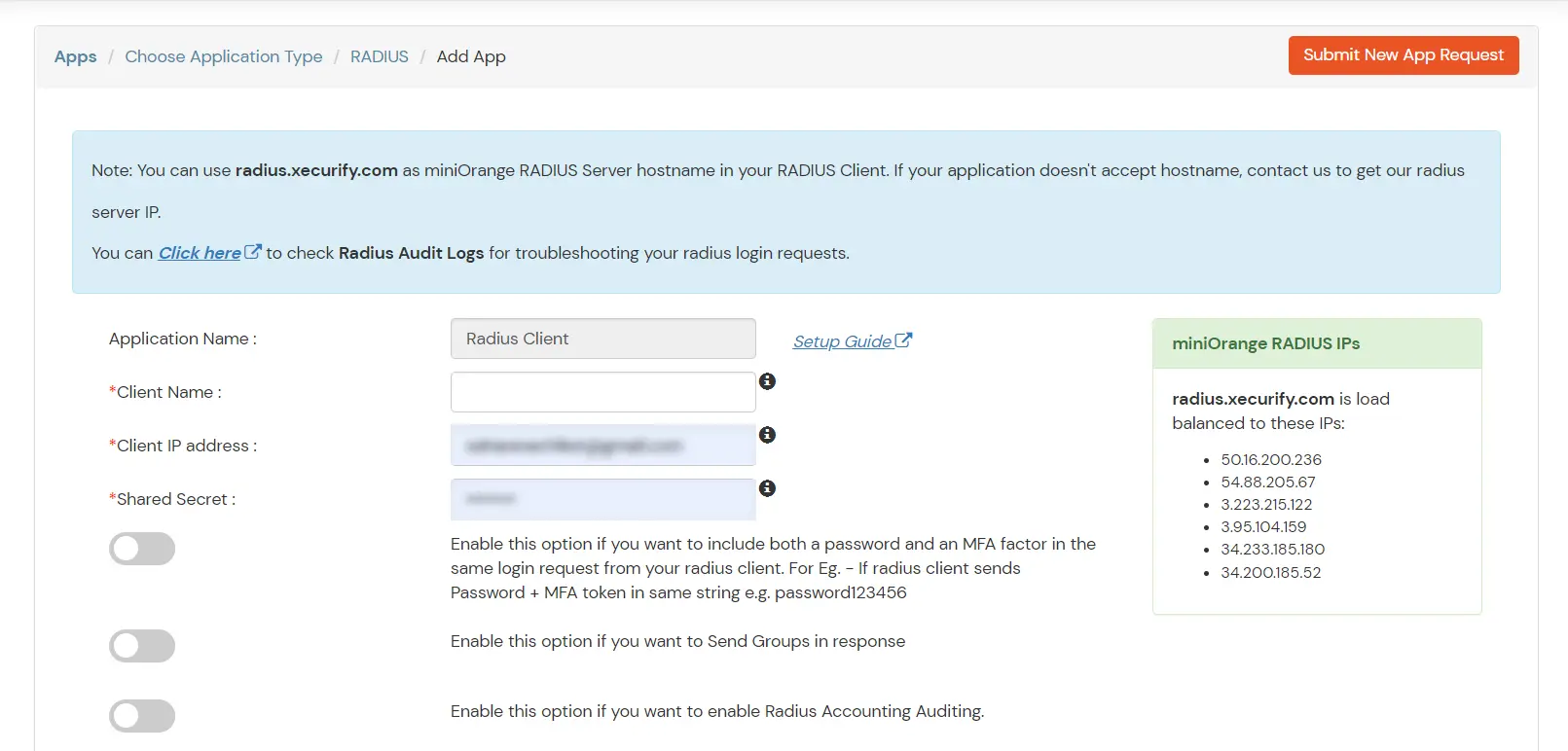
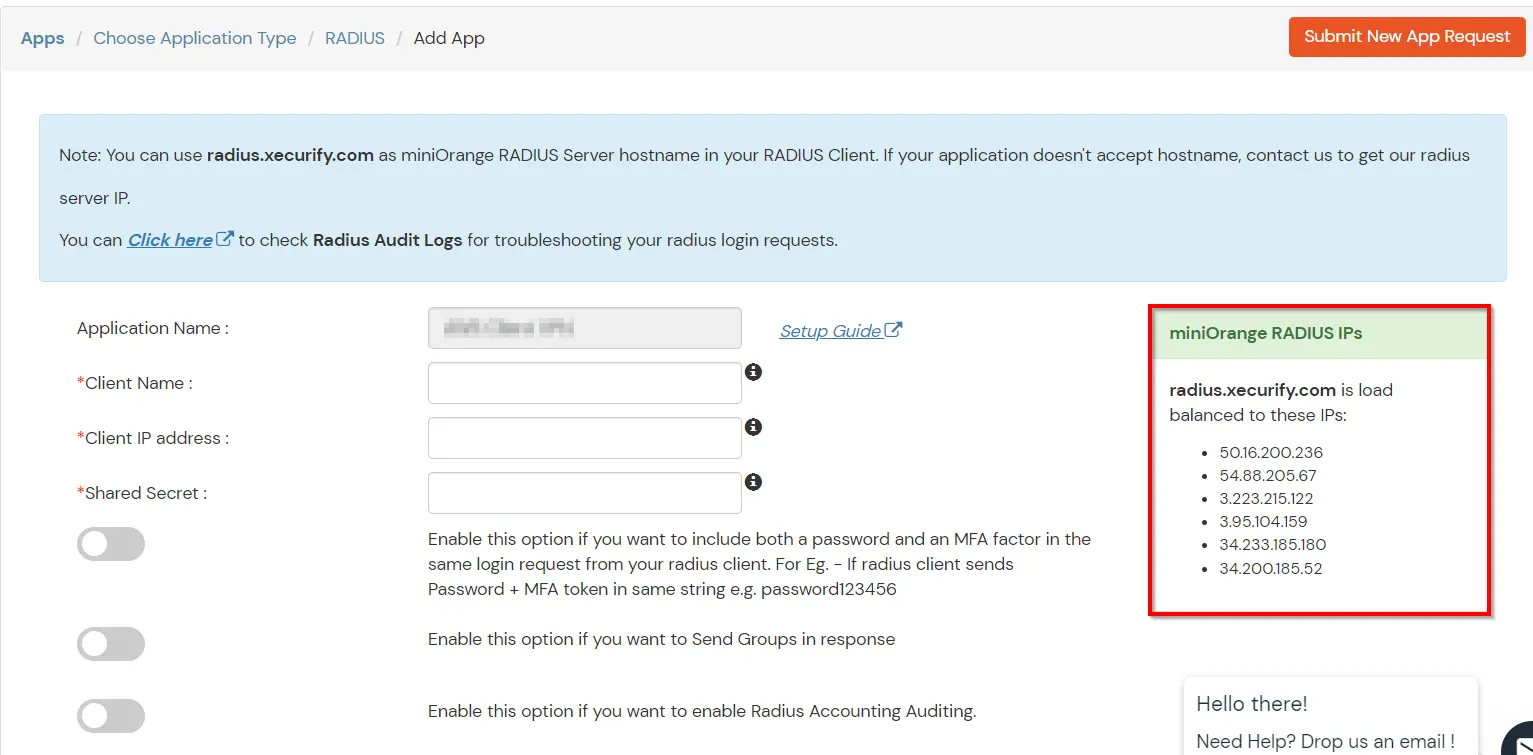
NOTE: For On-Premise version follow the below steps before testing the connectivity.
Only For On-Premise Version
Open Firewall Ports.
NOTE: If your machine is hosted on AWS, then enable the ports from the AWS panel.
2. Enable automatic user creation in Sophos
- Sign in to the Sophos UTM Web Administrator console with sufficient privileges.
- Navigate to Definitions & Users > Authentication Services, and then click Add to define a new RADIUS server.
- On the Global Settings tab check the box to Create users automatically, as shown below:
- In the Automatic User Creation for Facilities check the appropriate facilities for your environment, as shown above.
Recommendation: Select Client Authentication and End-User Portal.
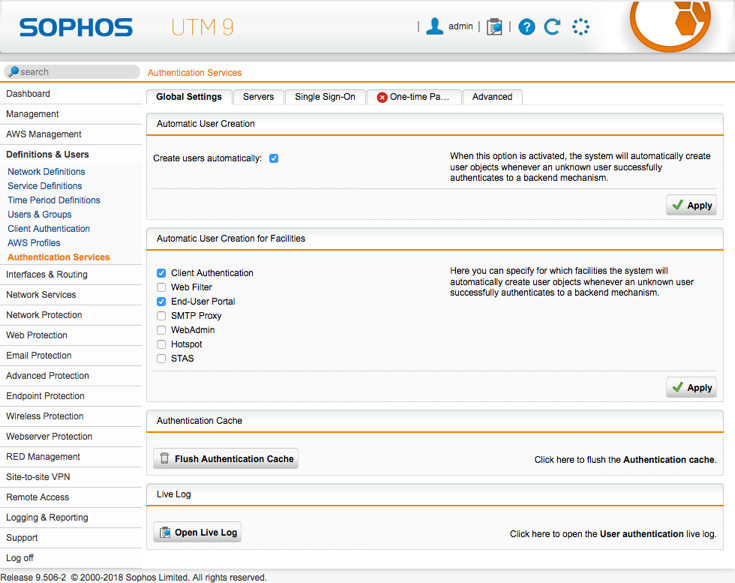
3. Configure a New Authentication Server
- In the Sophos UTM Web Admin console, navigate to Definitions & Users > Authentication Services, and select the Servers tab. The screen shown below opens.
- Click the New Authentication Server... button.
- Configure the Following Details:
- Click on the Save button.
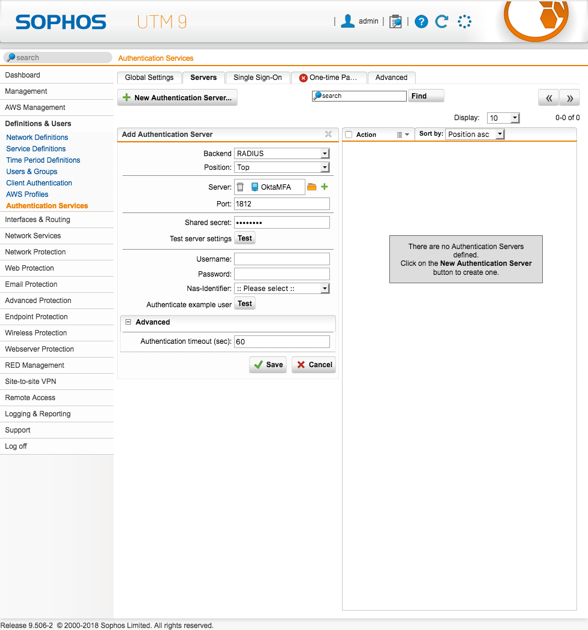
| Backend: | RADIUS |
| Position: | Top |
| Server | |
| Name: | Unique and appropriate name |
| Type: | Host |
| IPV4 address: | For on-premise version: IP of server where IDP(miniOrange) is installed For cloud version: Contact us at info@xecurify.com to get the IP |
| Interface: | The appropriate interface for your environment |
| Port: | 1812 |
| Shared Secret: | Secret Key for the Sophos (RADIUS) App defined in step 1 |
| Authentication timeout (sec): | 60 |
4. Create a RADIUS Backend Group in Sophos
- In the Sophos UTM Web Admin console, navigate to Definitions & Users > Users & Groups, and select the Groups tab. The screen shown below opens.
- Click New Group...
- Configure the Add Group Section with the following information:
- Click Save to save the settings.
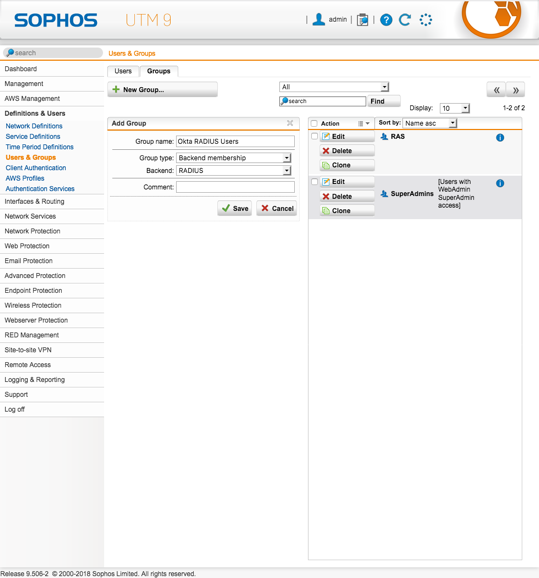
| Group Name: | Unique and appropriate name |
| Group Type: | Backend Membership |
| Backend: | RADIUS |
5. Allow group access to resources
- In the Sophos UTM Web Admin console, navigate to Remote Access, and select the desired connection method. The screen shown below opens.
- Click New HTML5 VPN Portal Connection... or use an existing connection.
- Add the group you created in Step 4 to the Users and Groups or Allowed Users (Userportal) list.
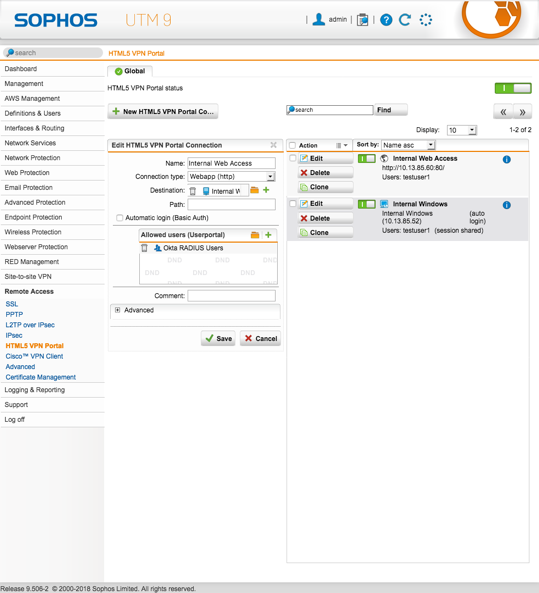
6. Configure Your User Directory (Optional)
miniOrange provides user authentication from various external sources, which can be Directories (like ADFS, Microsoft Active Directory, Azure AD, OpenLDAP, Google, AWS Cognito etc), Identity Providers (like Okta, Shibboleth, Ping, OneLogin, KeyCloak), Databases (like MySQL, Maria DB, PostgreSQL) and many more. You can configure your existing directory/user store or add users in miniOrange.
- Setup AD/LDAP as User Directory
- Setup miniOrange as User Directory
Configure your existing directories such as Microsoft Active Directory, Azure, OpenLDAP, etc.
- Click on User Stores >> Add User Store in the left menu of the dashboard.
- Select User Store type as AD/LDAP.
- STORE LDAP CONFIGURATION IN MINIORANGE : Choose this option if you want to keep your configuration in miniOrange. If active directory is behind a firewall, you will need to open the firewall to allow incoming requests to your AD.
- STORE LDAP CONFIGURATION ON PREMISE : Choose this option if you want to keep your configuration in your premise and only allow access to AD inside premises. You will have to download and install miniOrange gateway in your premise.
- Enter LDAP Display Name and LDAP Identifier name.
- Select Directory Type as Active Directory.
- Enter the LDAP Server URL or IP Address against LDAP Server URL field.
- Click on Test Connection button to verify if you have made a successful connection with your LDAP server.
- In Active Directory, go to the properties of user containers/OU's and search for Distinguished Name attribute.
- Enter the valid Bind account Password.
- Click on Test Bind Account Credentials button to verify your LDAP Bind credentials for LDAP connection.
- Search Base is the location in the directory where the search for a user begins. You will get this from the same place you got your Distinguished name.
- Select a suitable Search filter from the drop down menu. To use custom Search Filter select "Custom Search Filter" option and customize it accordingly.
- You can also configure following options while setting up AD. Enable Activate LDAP in order to authenticate users from AD/LDAP. Click on the Save button to add user store.
- Click on Save. After this, it will show you the list of User stores. Click on Test Configuration to check whether you have enter valid details. For that, it will ask for username and password.
- On Successful connection with LDAP Server, a success message is shown.
- Click on Test Attribute Mapping.
- Enter a valid Username. Then, click on Test. Mapped Attributes corresponding to the user are fetched.
- After successful Attribute Mapping Configuration, go back to the ldap configuration and enable Activate LDAP in order to authenticate users from AD/LDAP.



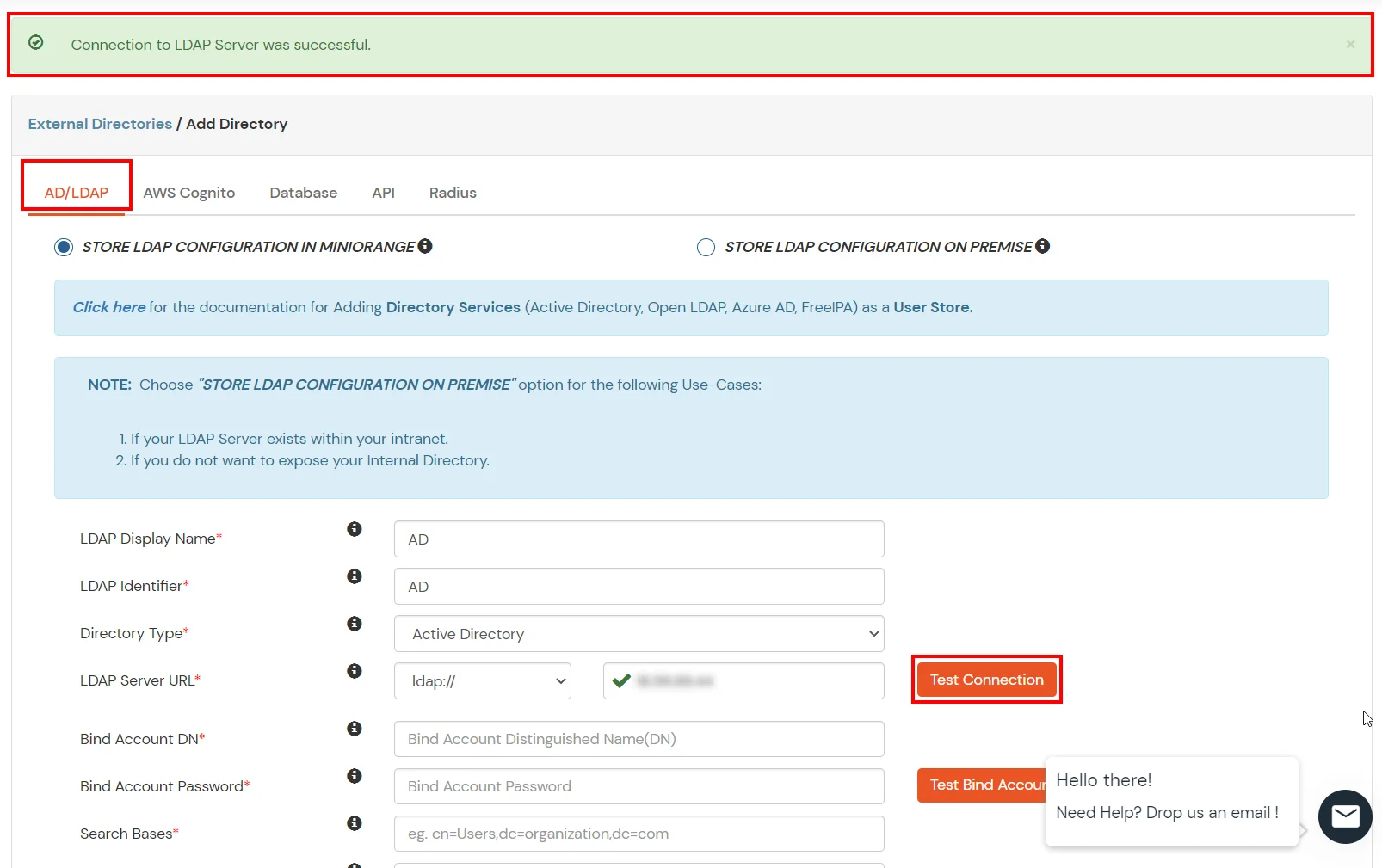
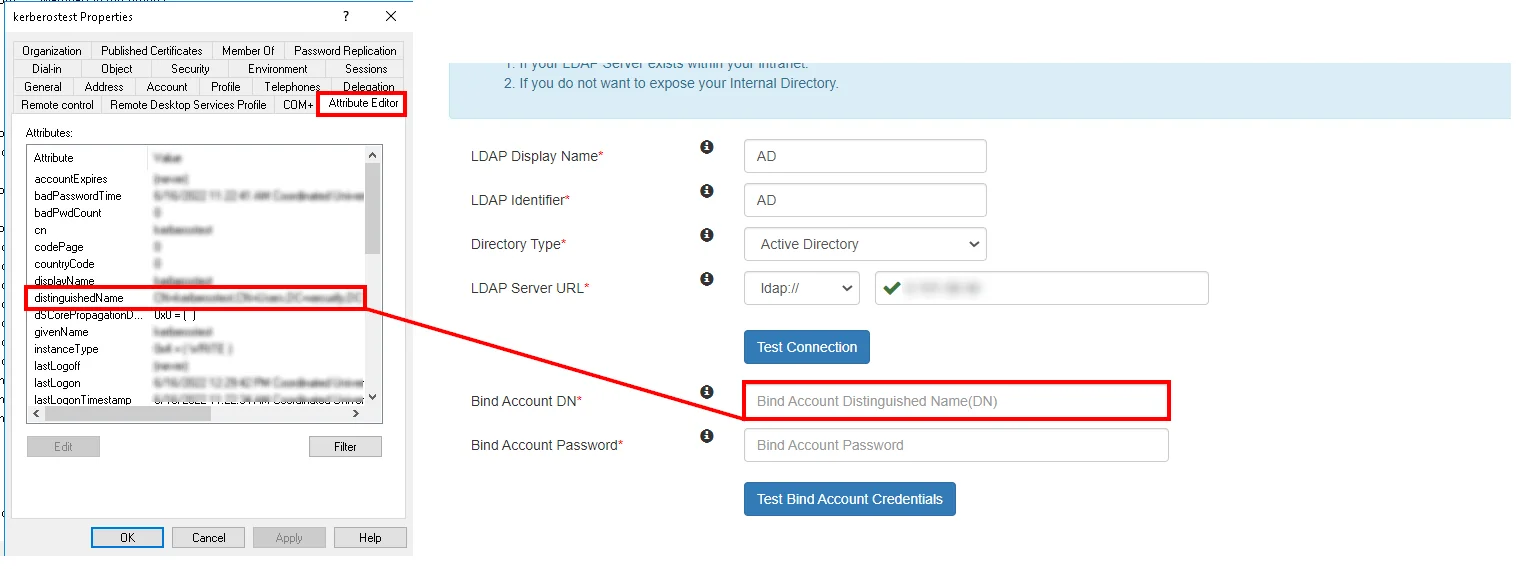


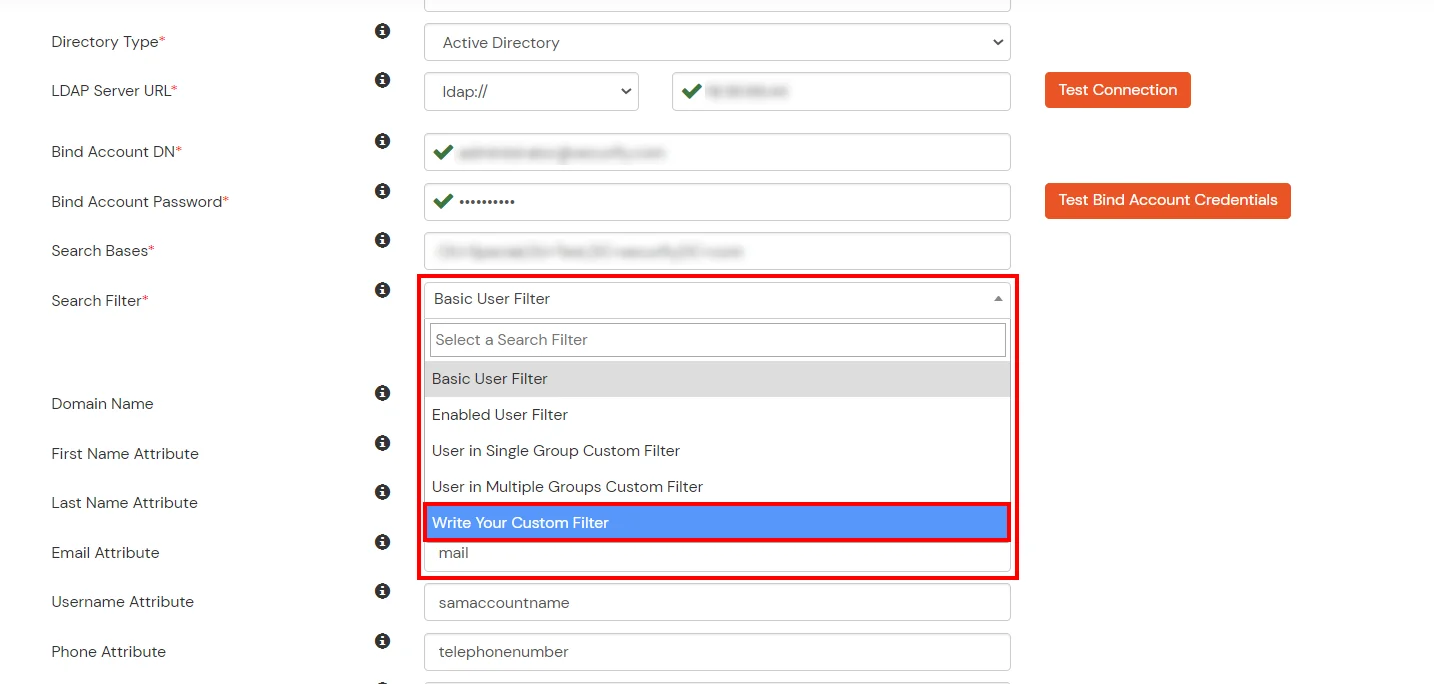
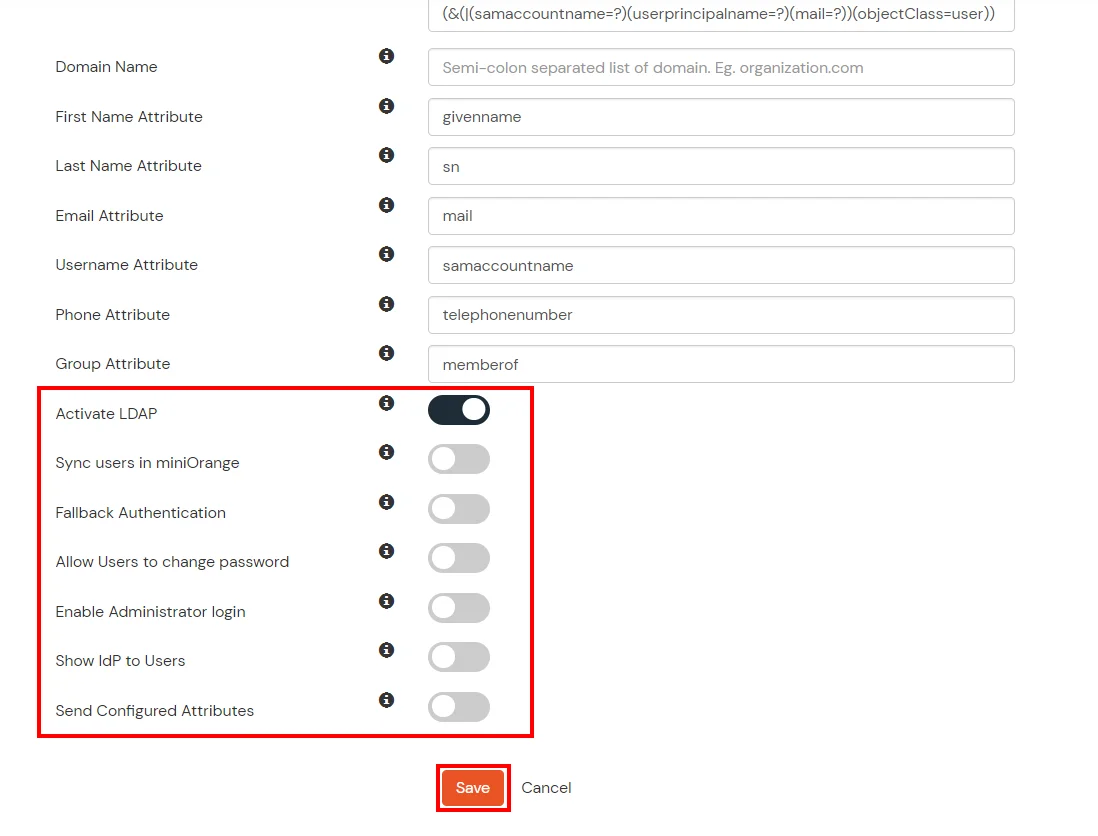
Here's the list of the attributes and what it does when we enable it. You can enable/disable accordingly.
| Attribute | Description |
|---|---|
| Activate LDAP | All user authentications will be done with LDAP credentials if you Activate it |
| Sync users in miniOrange | Users will be created in miniOrange after authentication with LDAP |
| Backup Authentication | If LDAP credentials fail then user will be authenticated through miniOrange |
| Allow users to change password | This allows your users to change their password. It updates the new credentials in your LDAP server |
| Enable administrator login | On enabling this, your miniOrange Administrator login authenticates using your LDAP server |
| Show IdP to users | If you enable this option, this IdP will be visible to users |
| Send Configured Attributes | If you enable this option, then only the attributes configured below will be sent in attributes at the time of login |
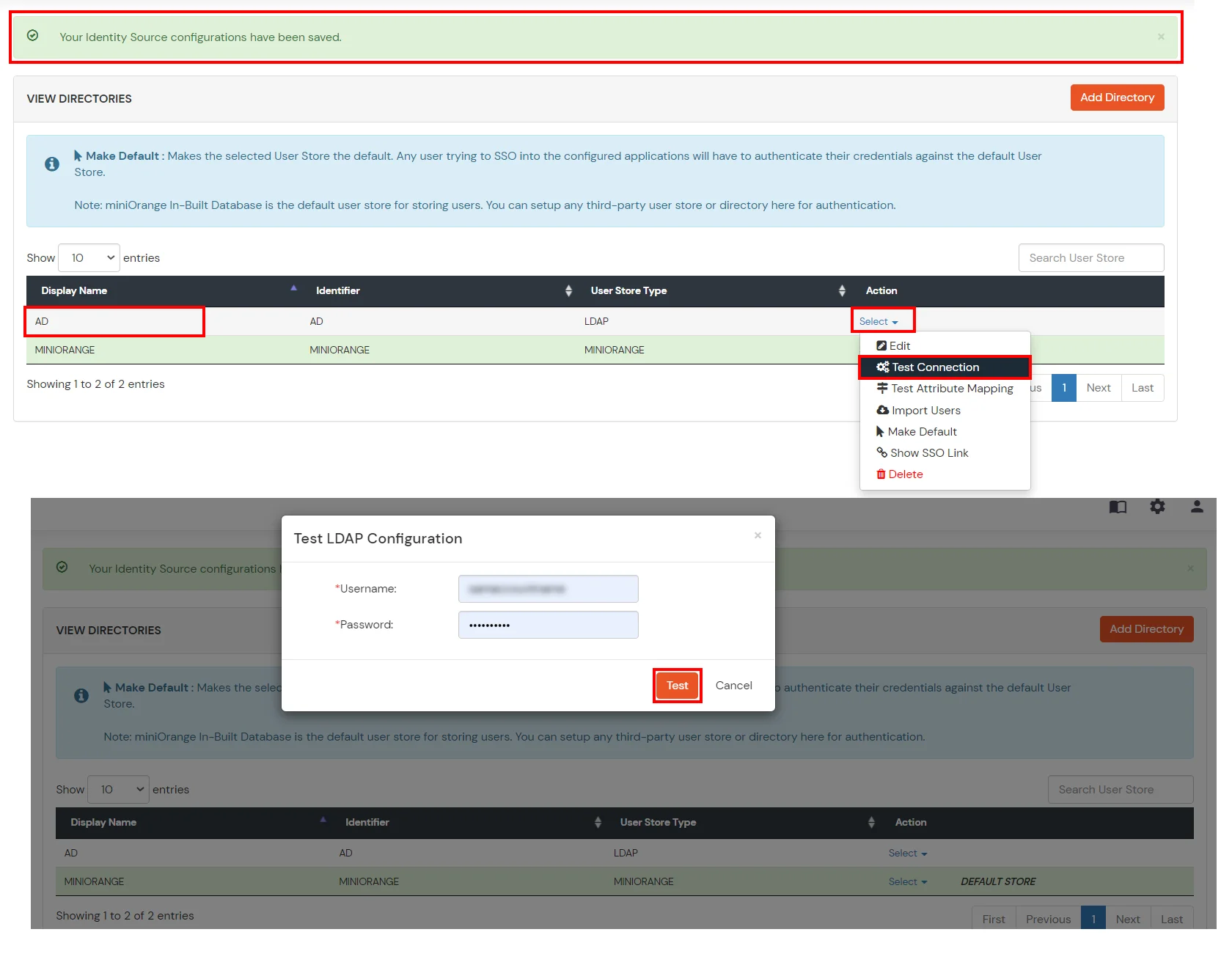


Refer our guide to setup LDAPS on windows server.
User Import and Provisioning from AD
Note: Below steps are used to enable one time or manual sync. To enable sync on scheduled basis, you should use LDAP gateway module. Read more and download the LDAP gateway module.
- Go to Settings in the Customer Admin Account.
- Enable the "Enable User Auto Registration" option and click Save.
- (Optional) To send a welcome email to all the end users that will be imported, enable the "Enable sending Welcome Emails after user registration" option and click Save.
- From the Left-Side menu of the dashboard select Provisioning.
- In Setup Provisioning tab select Active Directory in the Select Application Drop Down.
- Toggle the Import Users tab, click on Save button.
- On the same section, switch to Import Users section.
- Select Active Directory from the dropdown and click on the Import Users tab, to import all the users from Active Directory to miniOrange.
- You can view all the Users you have imports by selecting Users >> User List from Left Panel.
- All the imported users will be auto registered.
- These groups will be helpful in adding multiple 2FA policies on the applications.
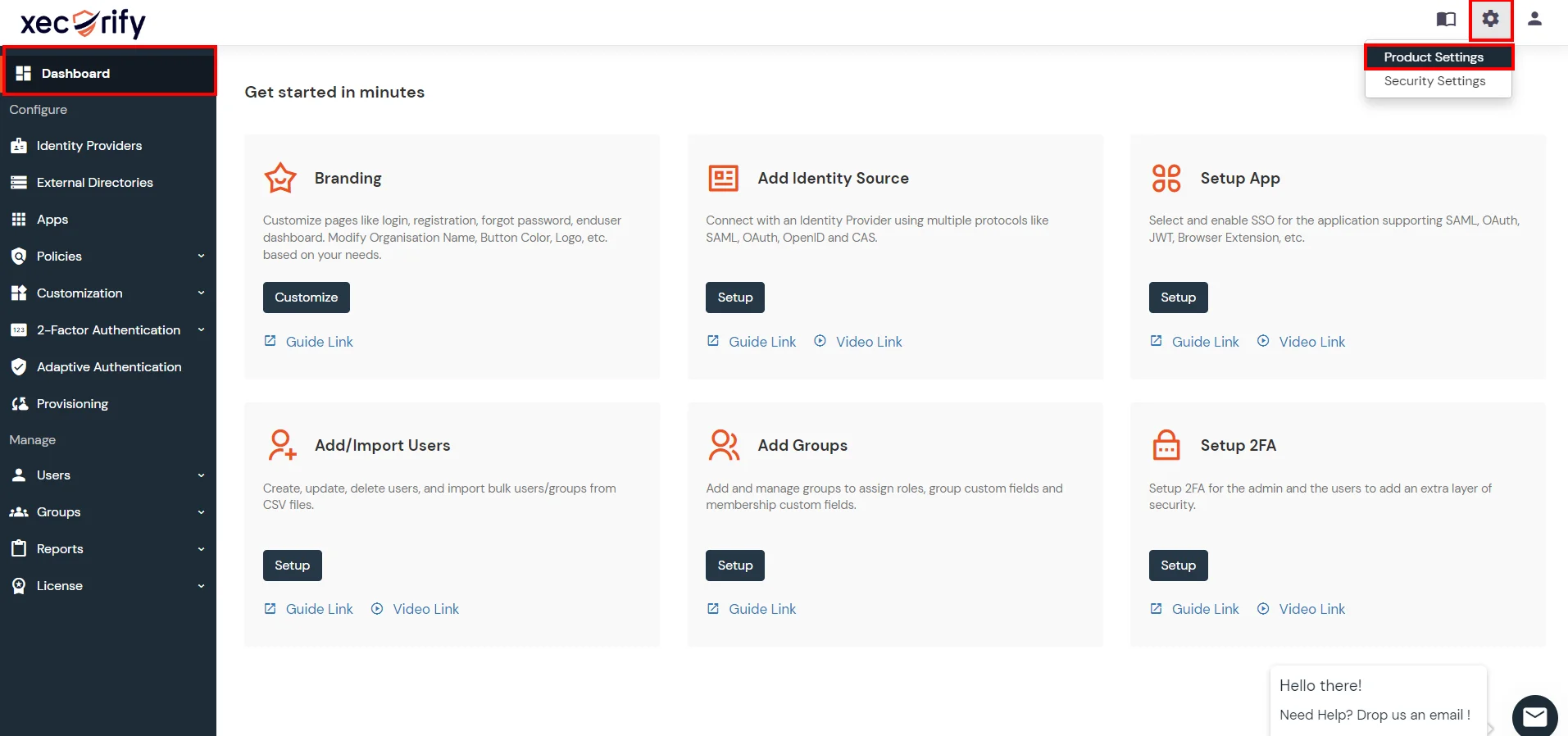


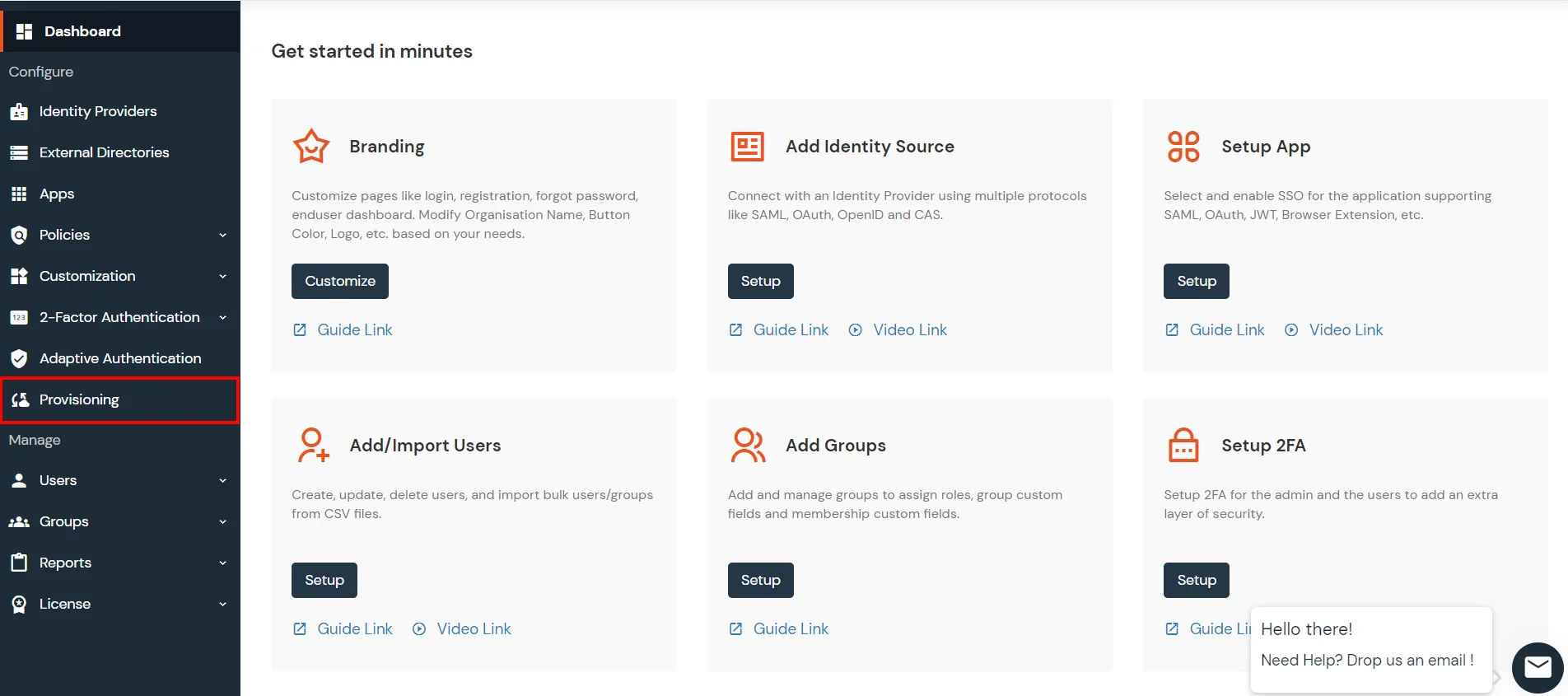
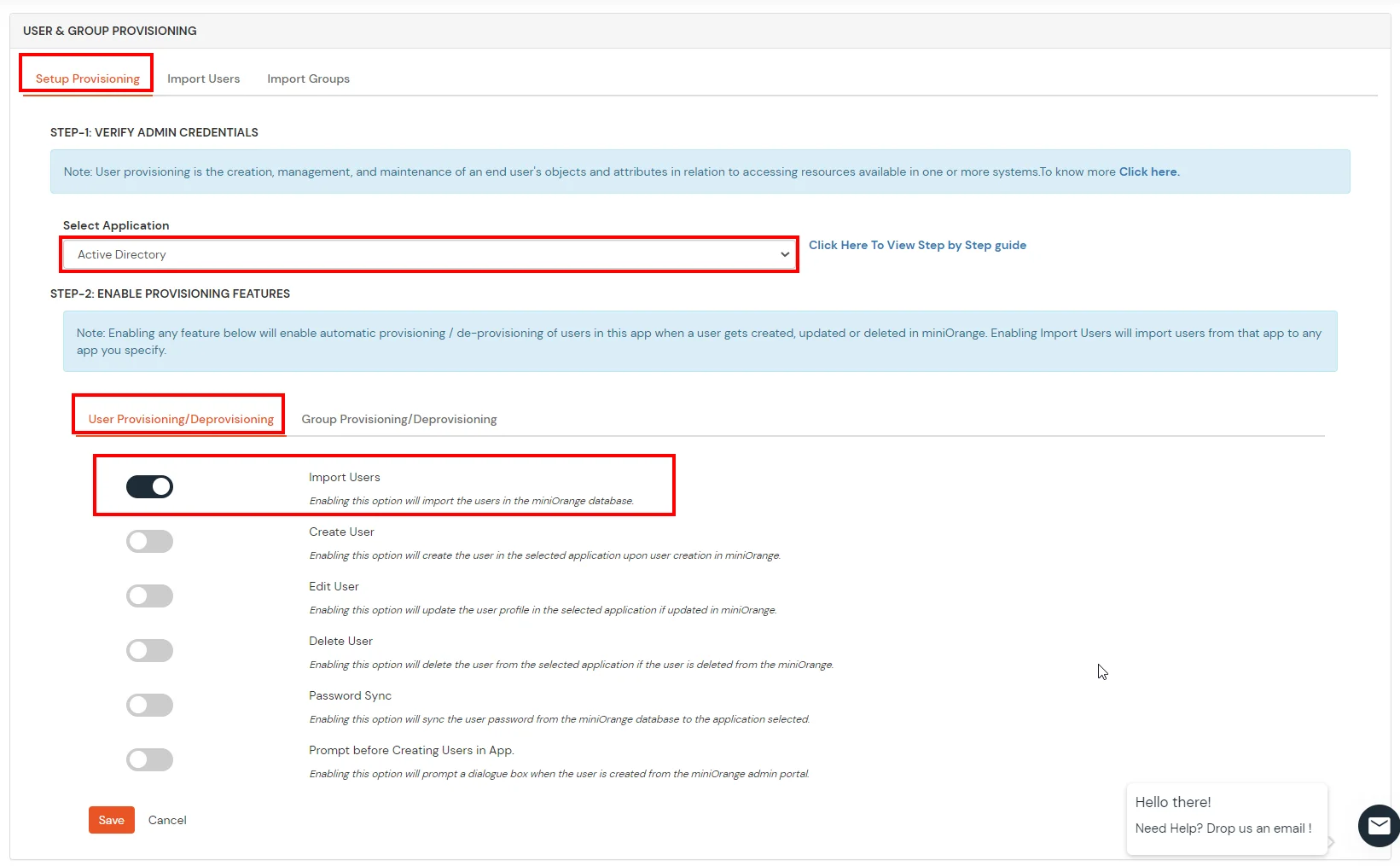

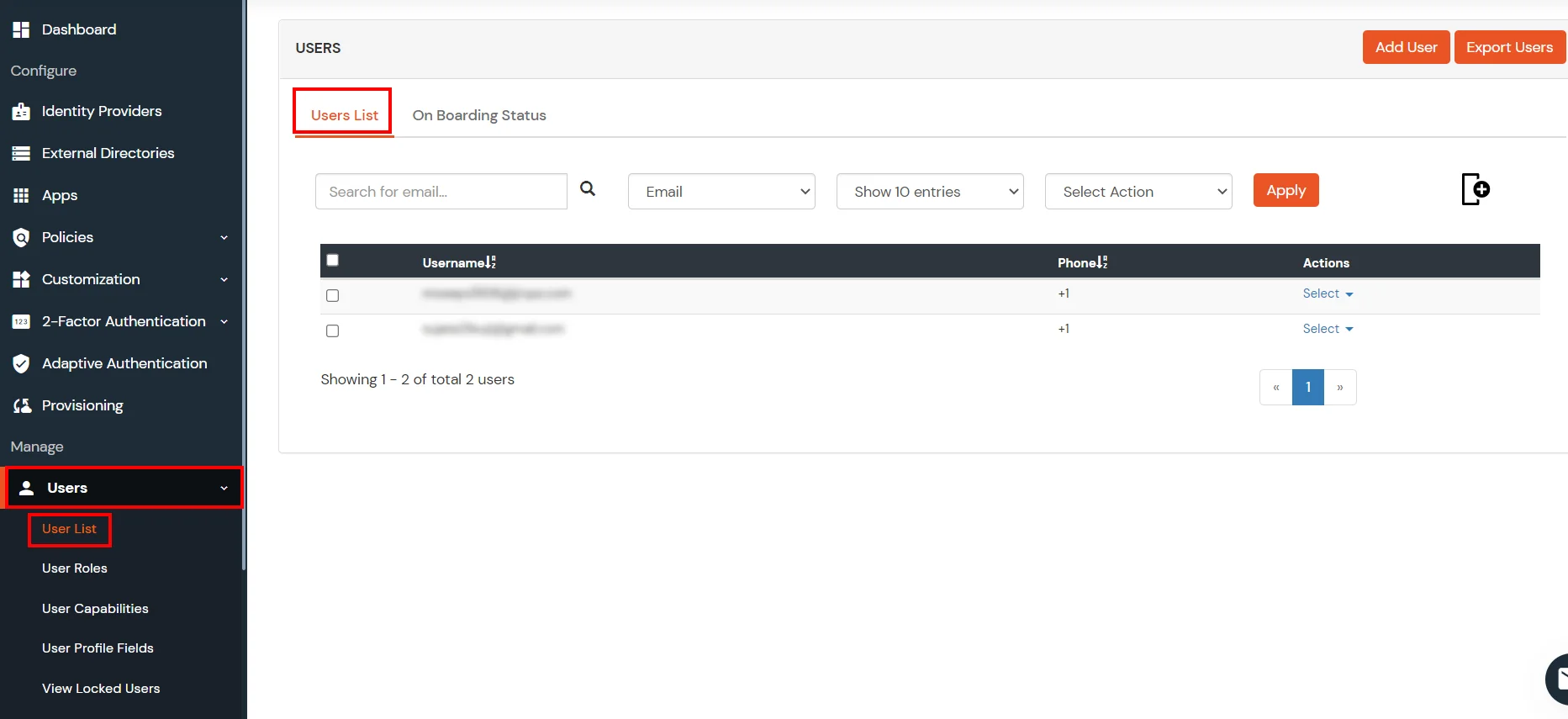
- To add your users in miniOrange there are 2 ways:
- Click on Users >> Add User.
- Here, fill the user details without the password and then click on the Create User button.
- After successful user creation a notification message "An end user is added successfully" will be displayed at the top of the dashboard.
- Click on On Boarding Status tab. Check the email, with the registered e-mail id and select action Send Activation Mail with Password Reset Link from Select Action dropdown list and then click on Apply button.
- Now, Open your email id. Open the mail you get from miniOrange and then click on the link to set your account password.
- On the next screen, enter the password and confirm password and then click on the Single Sign-On (SSO) reset password button.
- Now, you can log in into miniOrange account by entering your credentials.
- Navigate to Users >> User List. Click on Add User button.
- In Bulk User Registration Download sample csv format from our console and edit this csv file according to the instructions.
- To bulk upload users, choose the file make sure it is in comma separated .csv file format then click on Upload.
- After uploading the csv file successfully, you will see a success message with a link.
- Click on that link you will see list of users to send activation mail. Select users to send activation mail and click on Send Activation Mail. An activation mail will be sent to the selected users.
1. Create User in miniOrange
2. Bulk Upload Users
1. Create User in miniOrange
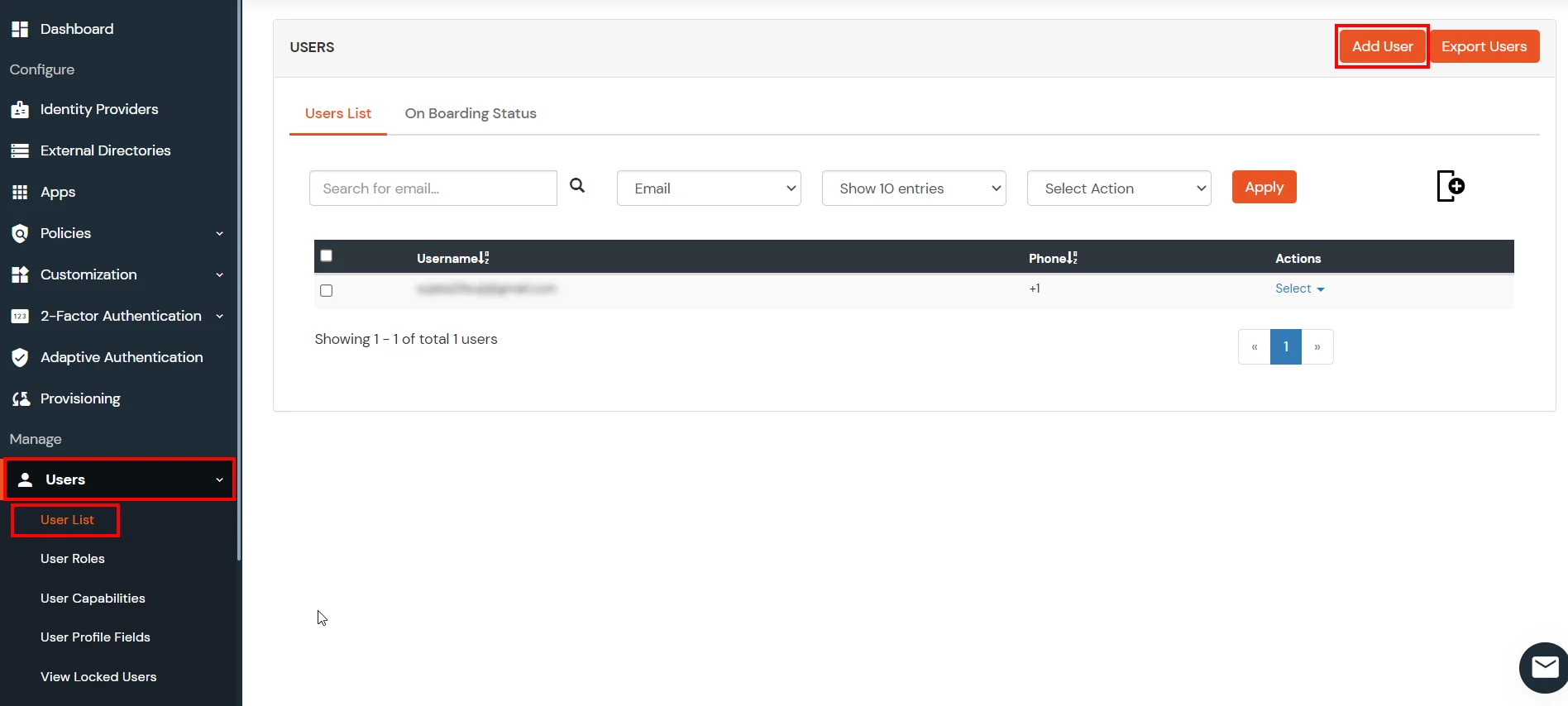

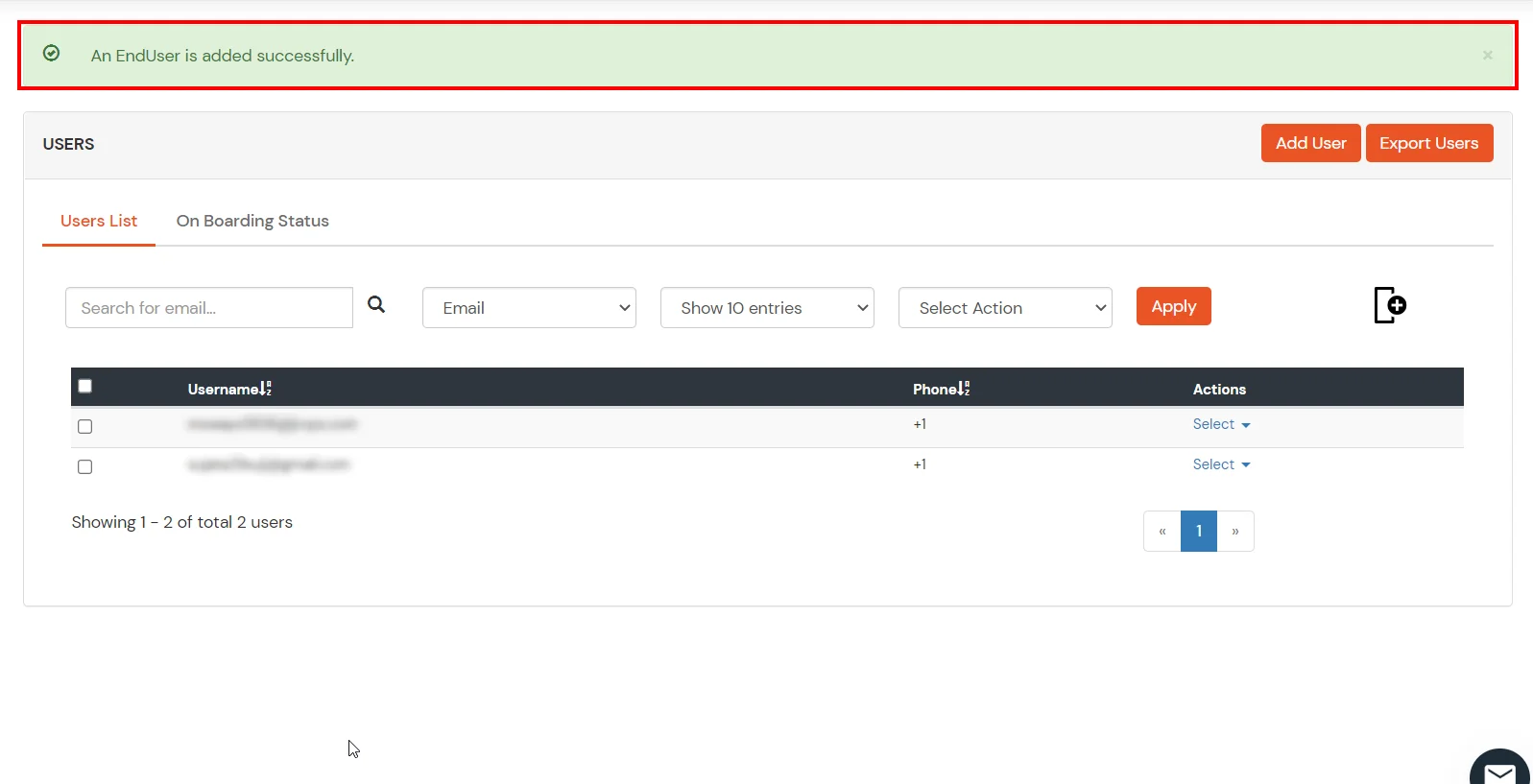


2. Bulk Upload Users in miniOrange via Uploading CSV File.

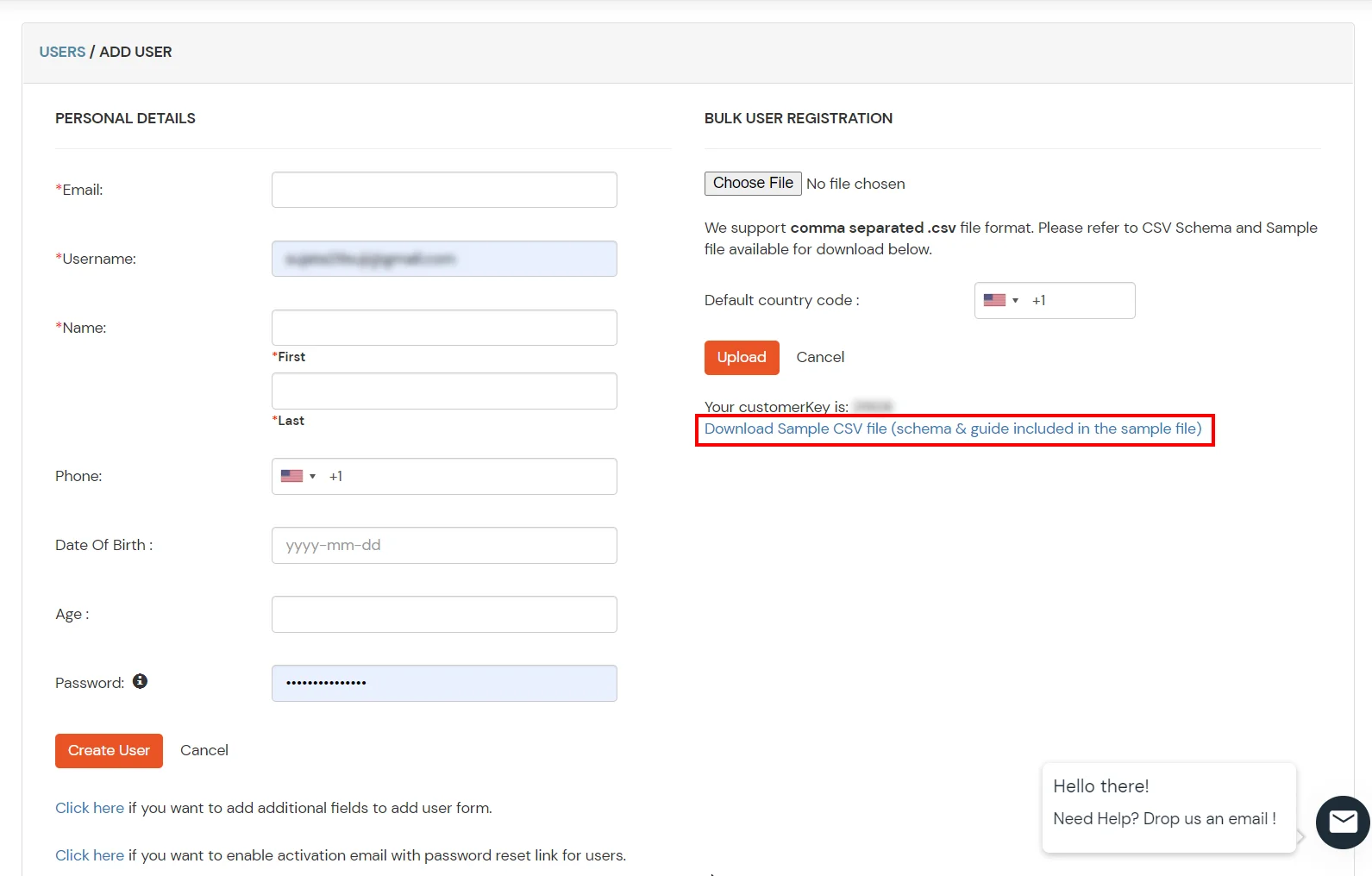
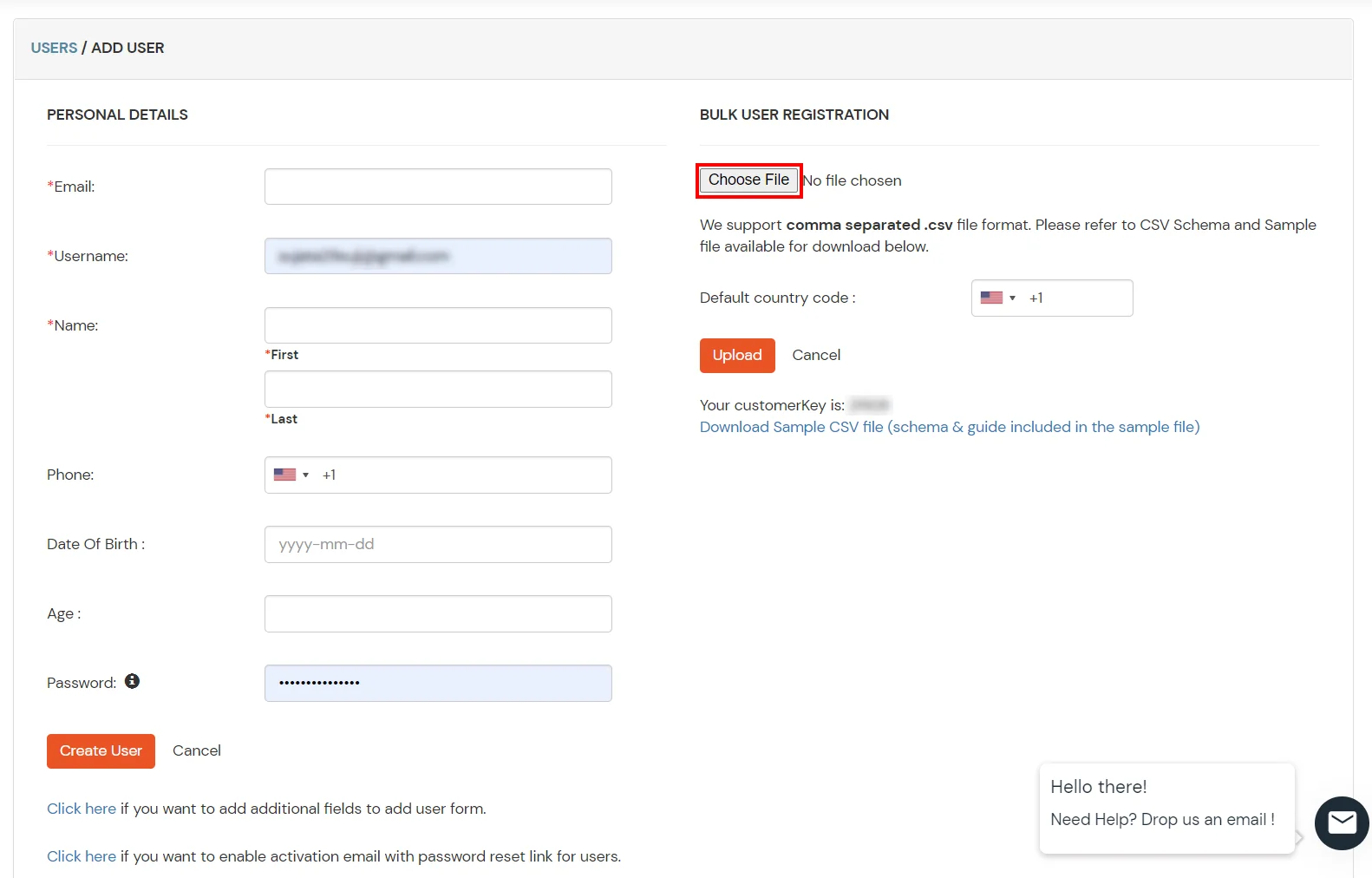
7. Creating User Groups (Recommended)
- AD user group
- miniOrage user group
- This step involves Importing the user group from the Active Directory and Provisioning them.
- Go to Provisioning. Switch to Setup Provisioning tab and select Active Directory from Dropdown menu.
- Select Group Provisioning/Deprovisioning tab, and toggle on Import Group option.
- If you want to dynamically allocate users to the groups present in the miniOrange, then enable "Assign Users to groups"
- Enter the Base DN for group sync and click Save.
- Now switch to Import Groups option and select Active Directory from which you want to import your users.
- Finally, click on Import button. Your group will be imported.
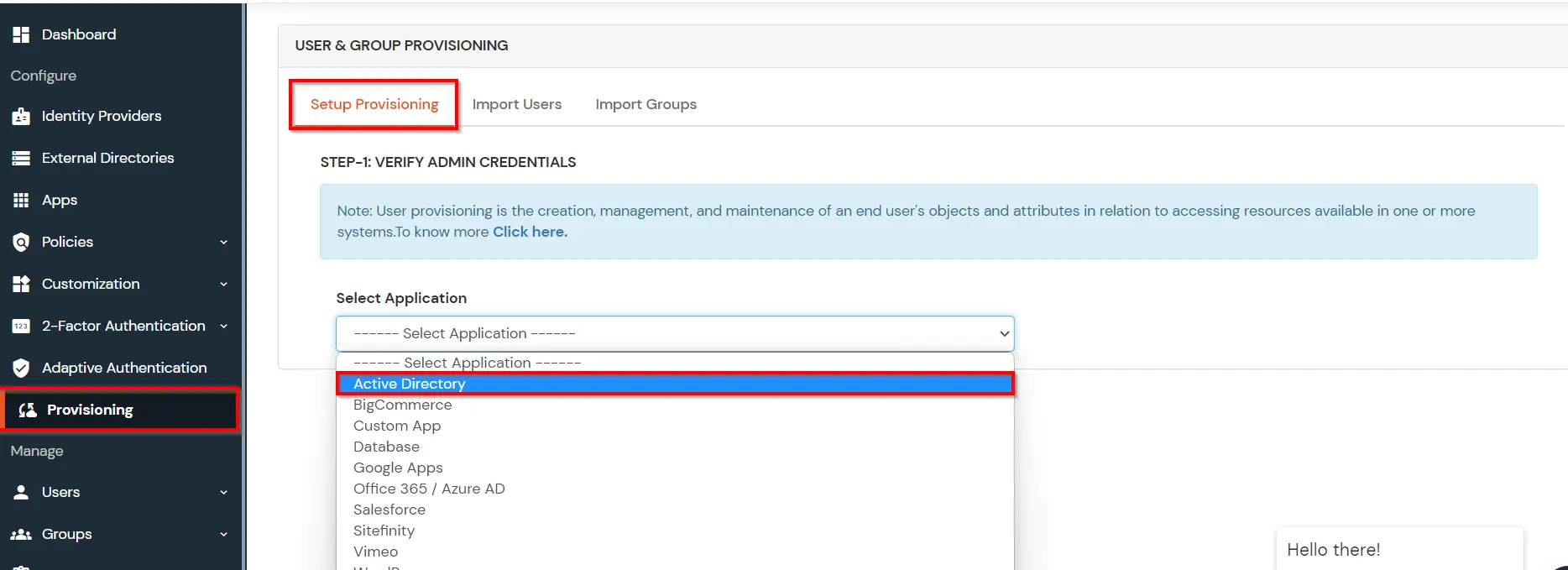
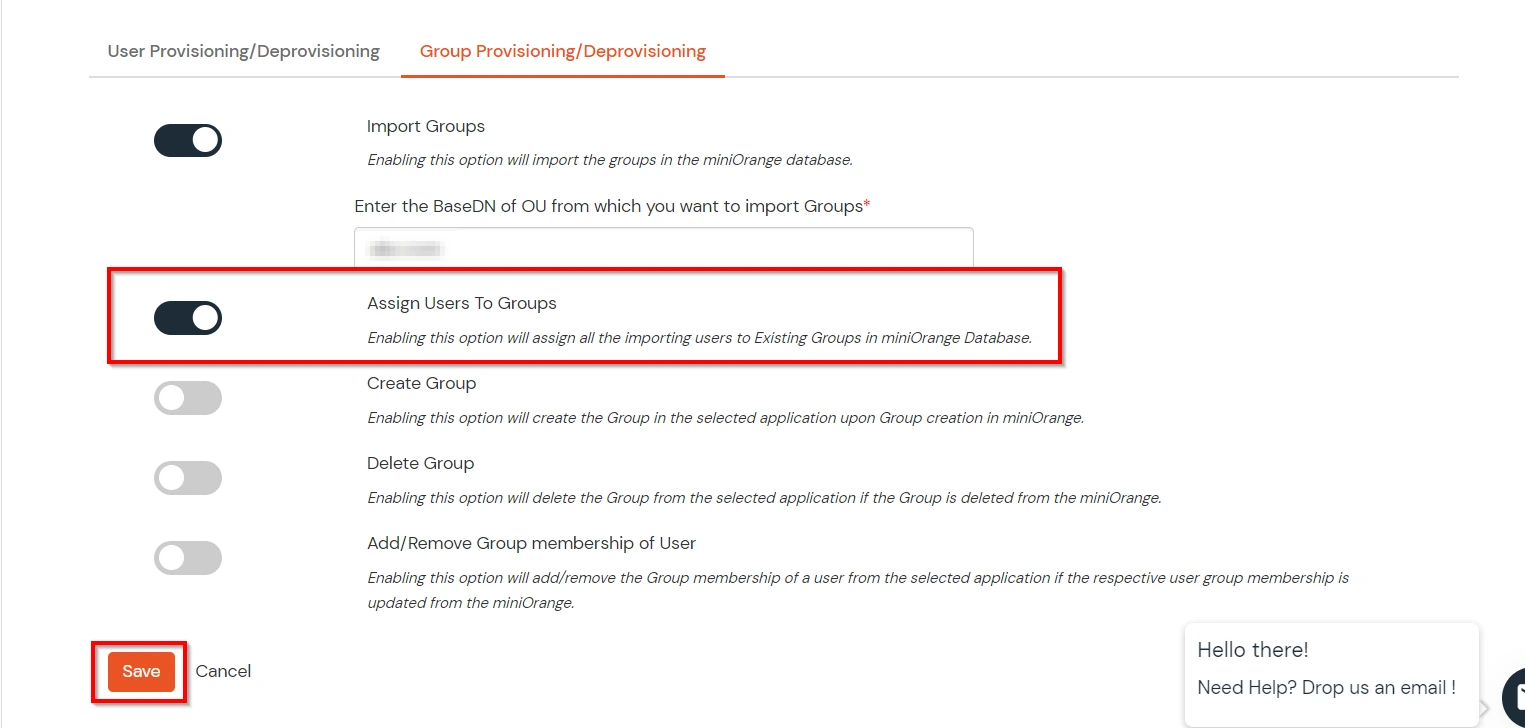

(The Active Directory Group Provisioning (Sync) setup is done. Now, whenever a user is created or modified in LDAP server and if the Assign Users to groups is enabled, then user group attribute from the LDAP server will be automatically synced and the user group will be assigned or changed accordingly in miniOrange.)
- Select Groups >> Manage Groups from left panel.
- Click on the Create Group button on the top.
- Enter an appropriate Group Name and click on Create Group.
- In this guide we have created a Group by name VPN_Group.
- Assign various members to the group using the Assign User option associated with the group in the groups list.
- Select the Users that are required to be assigned to this group. Then Select Assign to Group in Select Action Dropdown and click on Apply button.
- These groups will be helpful in adding multiple 2FA policies on the applications.
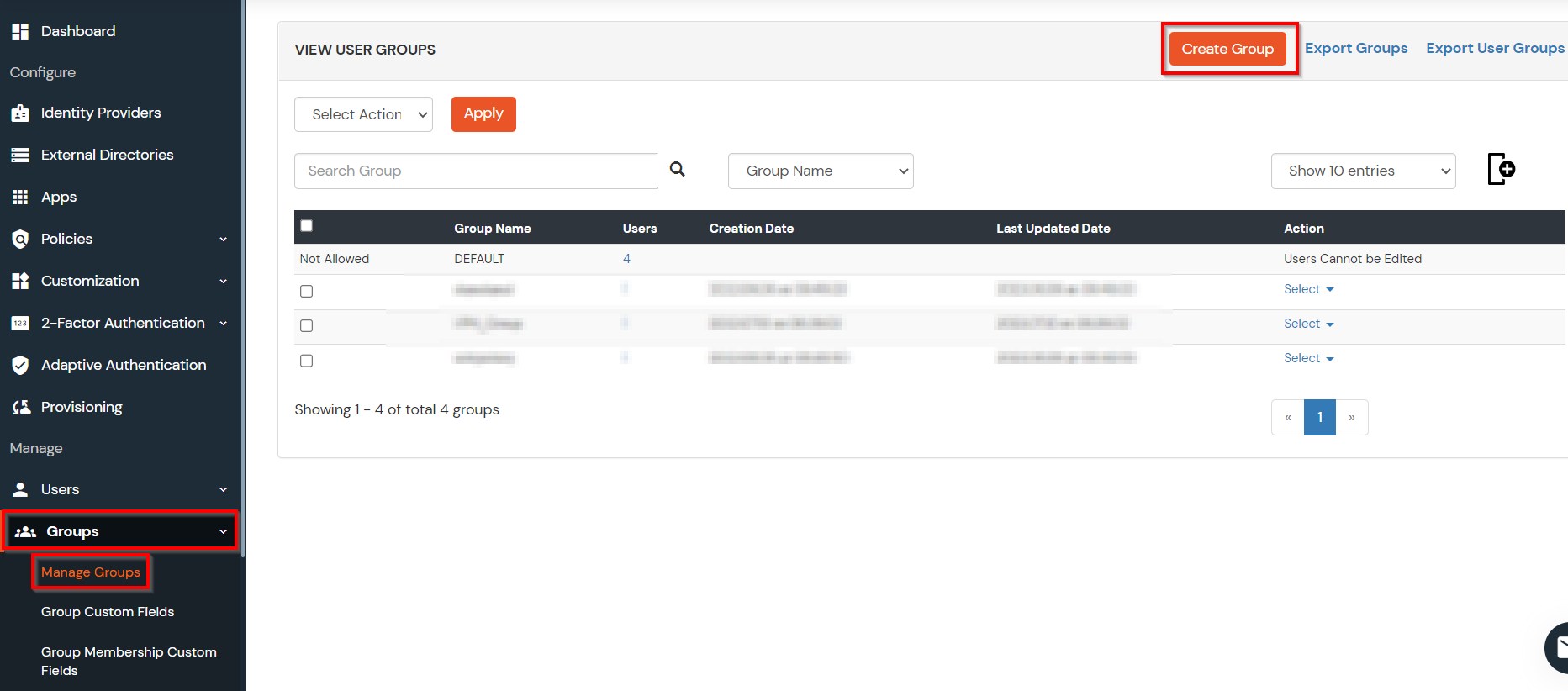

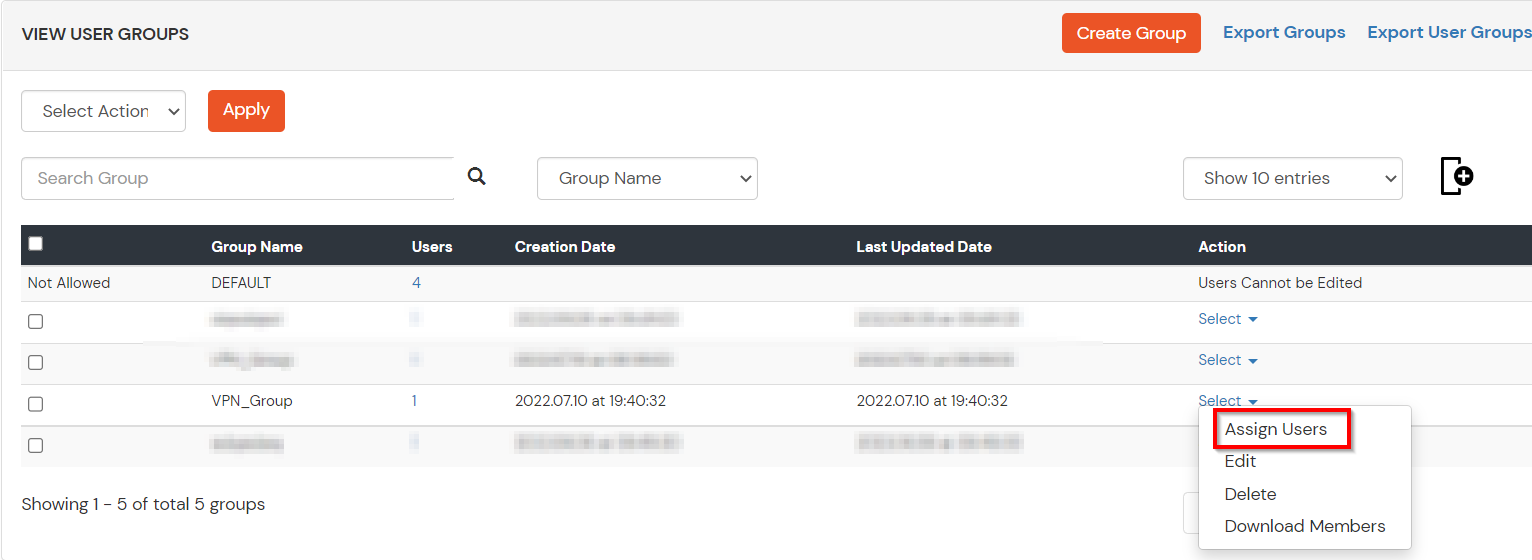
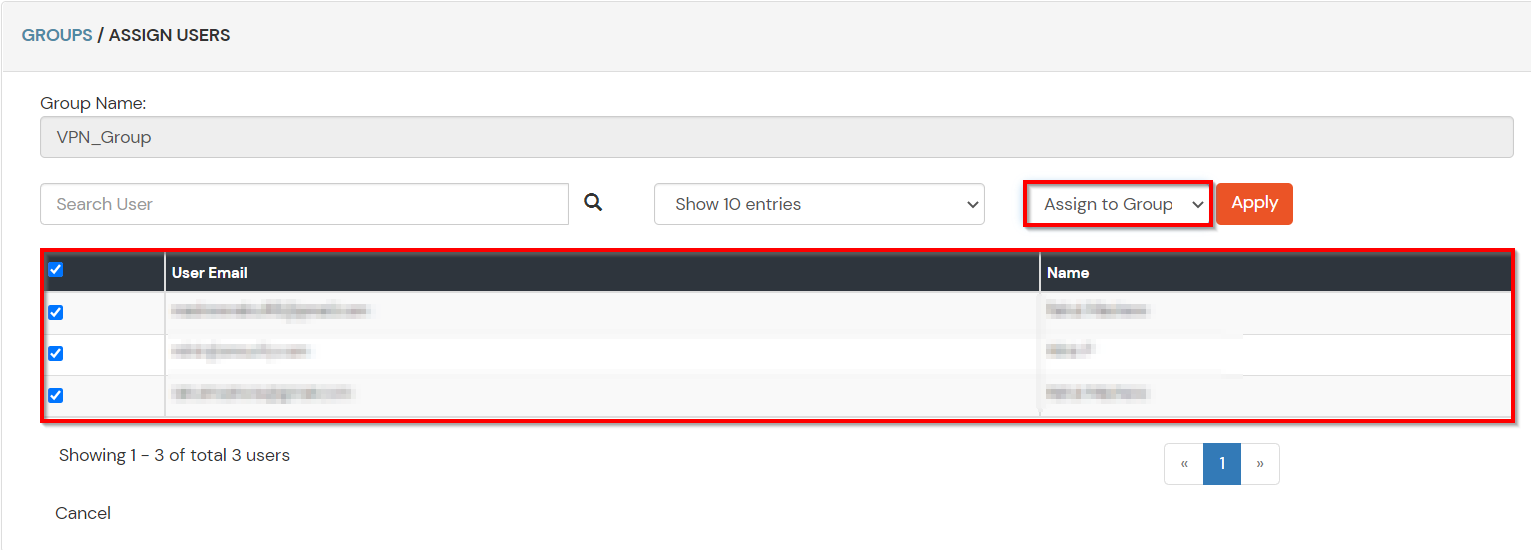
8. Configure 2FA/MFA for End-Users
- To enable 2FA/MFA for Sophos UTM endusers, go to 2-Factor Authentication >> 2FA Options For EndUsers.
- Select default Two-Factor authentication method for end users. Also, you can select particular 2FA methods, which you want to show on the end users dashboard.
- Once Done with the settings, click on Save to configure your 2FA settings.
- Login into your End-User Dashboard using end user login URL.
- For Cloud Version: The login URL (branding url) which you have set in Step 1
- For On-Premise version: The login URL will be the same as of Admin Login URL.
- Select Setup 2FA from left panel. (Browse through the Second factor options and choose an appropriate method to be used by the particular End-User during login.)
- For now, we have selected the SMS >> OTP OVER SMS as our 2FA method. You can explore the guide to setup other 2FA methods here.
- Enable the OTP over SMS if you have your phone number added under your profile section else click on Edit button.
- Enter you Phone Number along with the necessary country code and click on the SAVE button.
- Admin can change the second factor of the End user from the User List.
- Under Action Click on Select and then select Reset Second Factor.
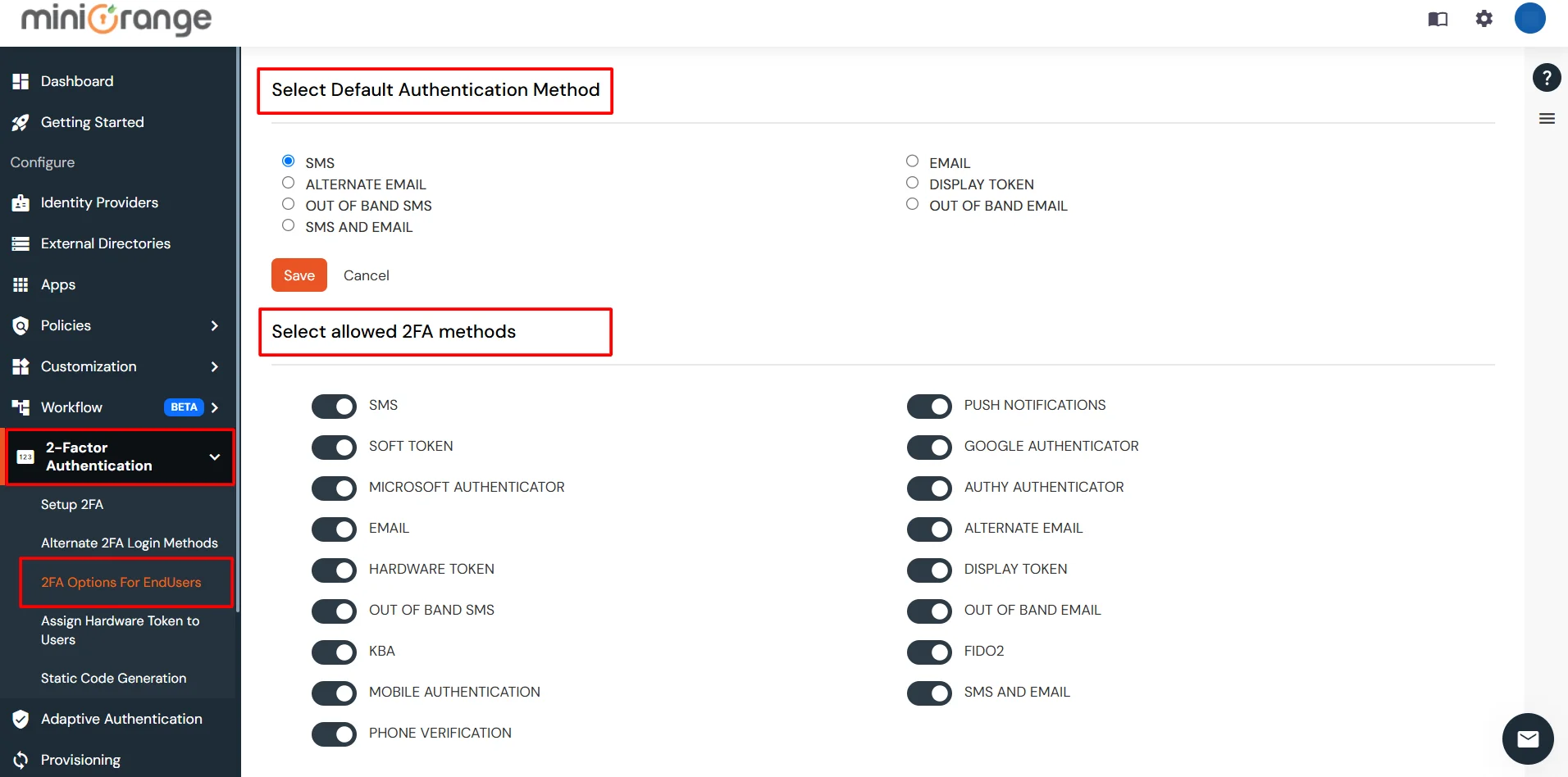
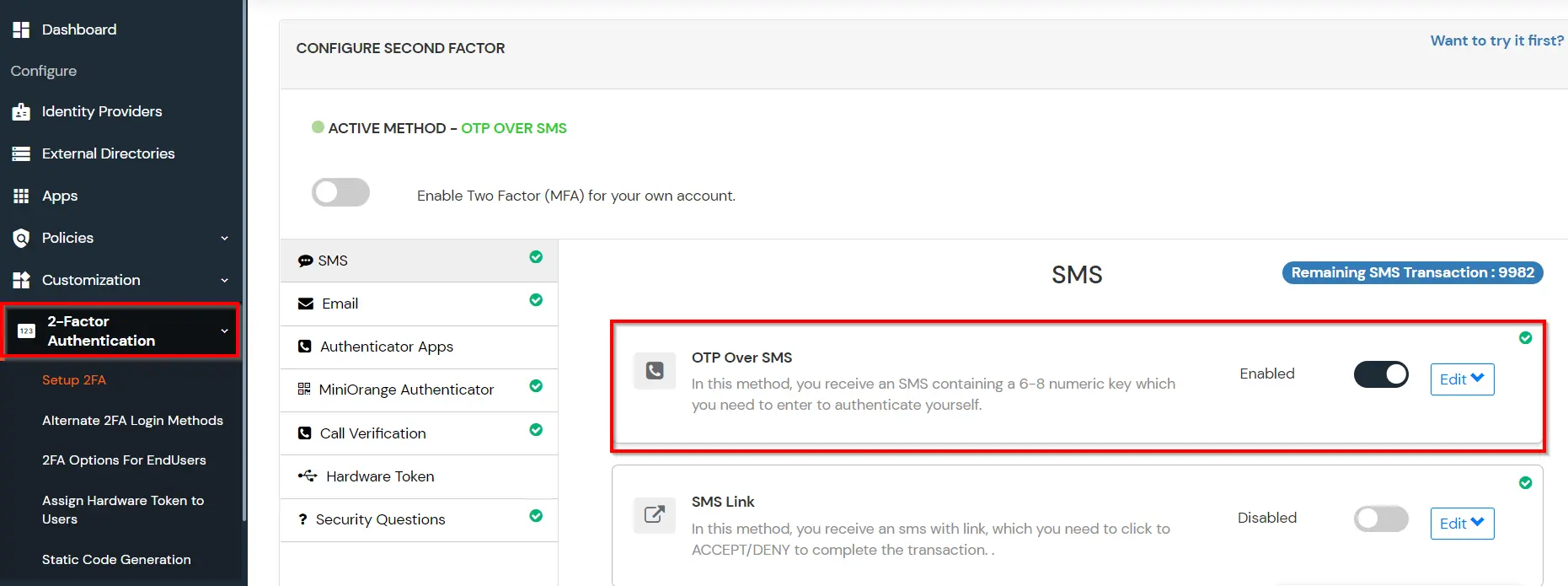
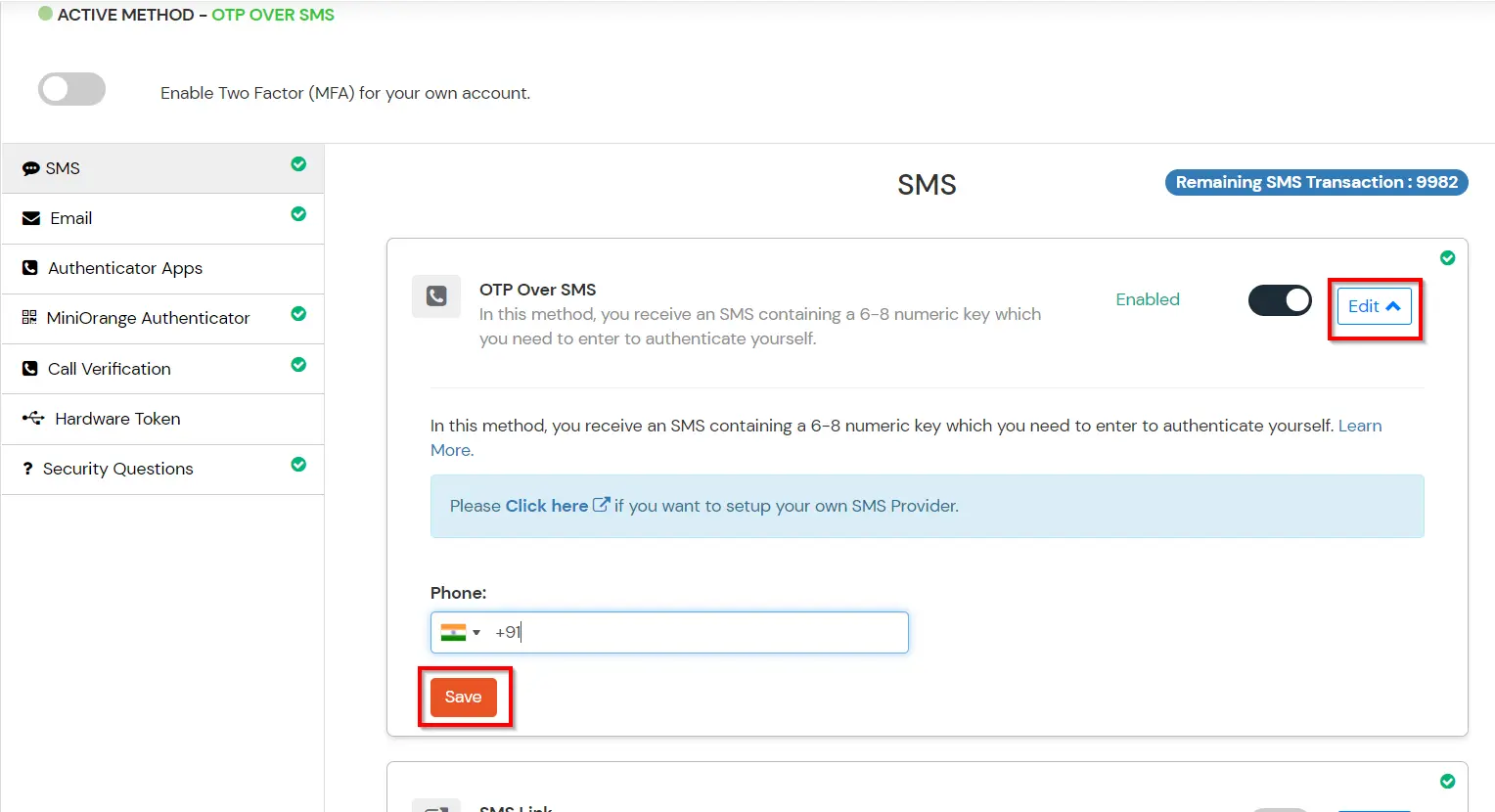

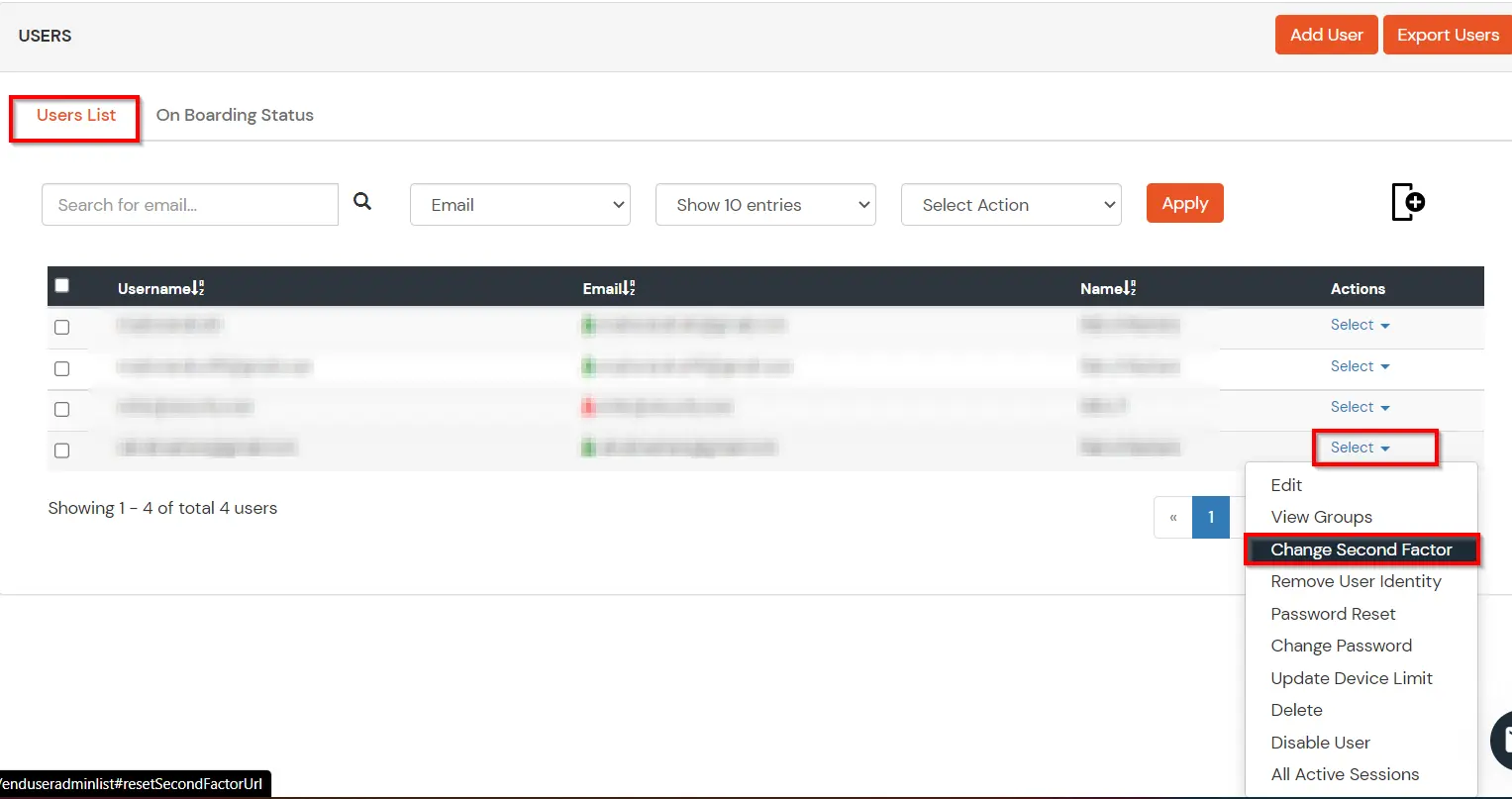
9. Add Another Policy (Optional)
- Here, we will configure a policy for the User Group that we created in the Step 7 and associate it with the Sophos UTM VPN Application.
- Click on Policies tab >> App Login Policy.
- Click on Add Policy tab.
- In Application section, select the RADIUS App that we configured earlier in Step 1.
- Select the required User Group in Group Name and enter the Policy name.
- In this guide, we will configure a Password Only policy for "VPN_Group", so that only the VPN_Group members can access VPN Services without a Second Factor.
- Once done with the policy settings, click on Save to Add Policy.
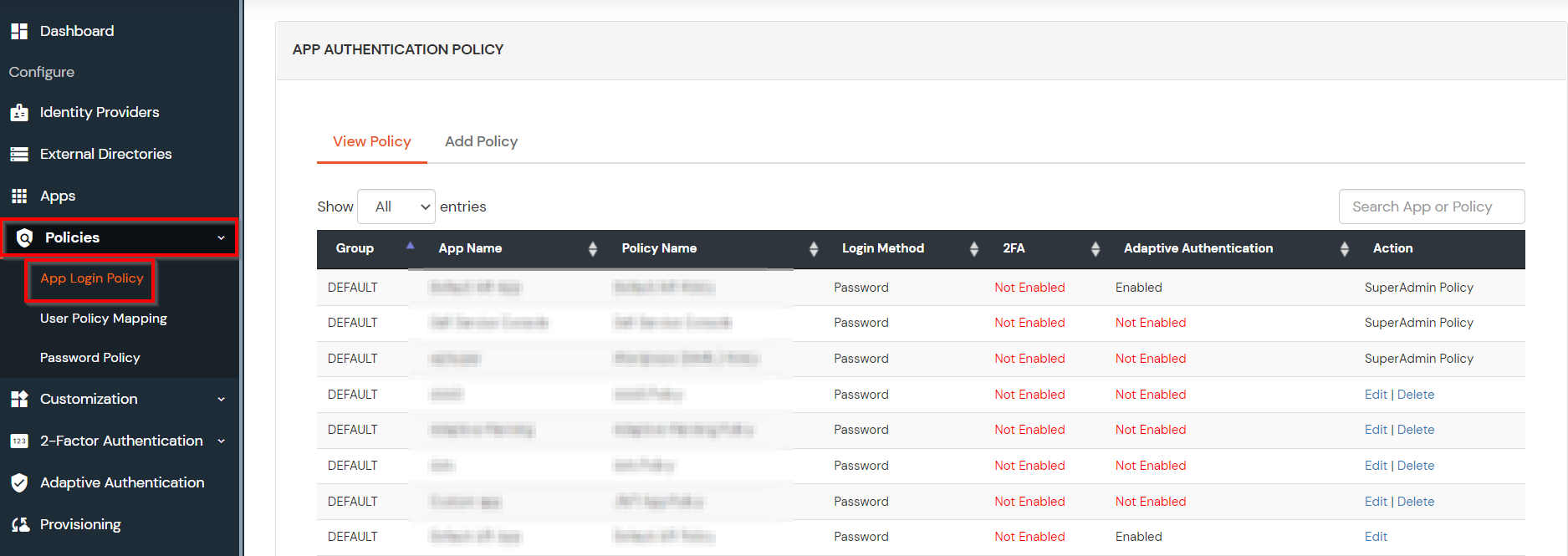
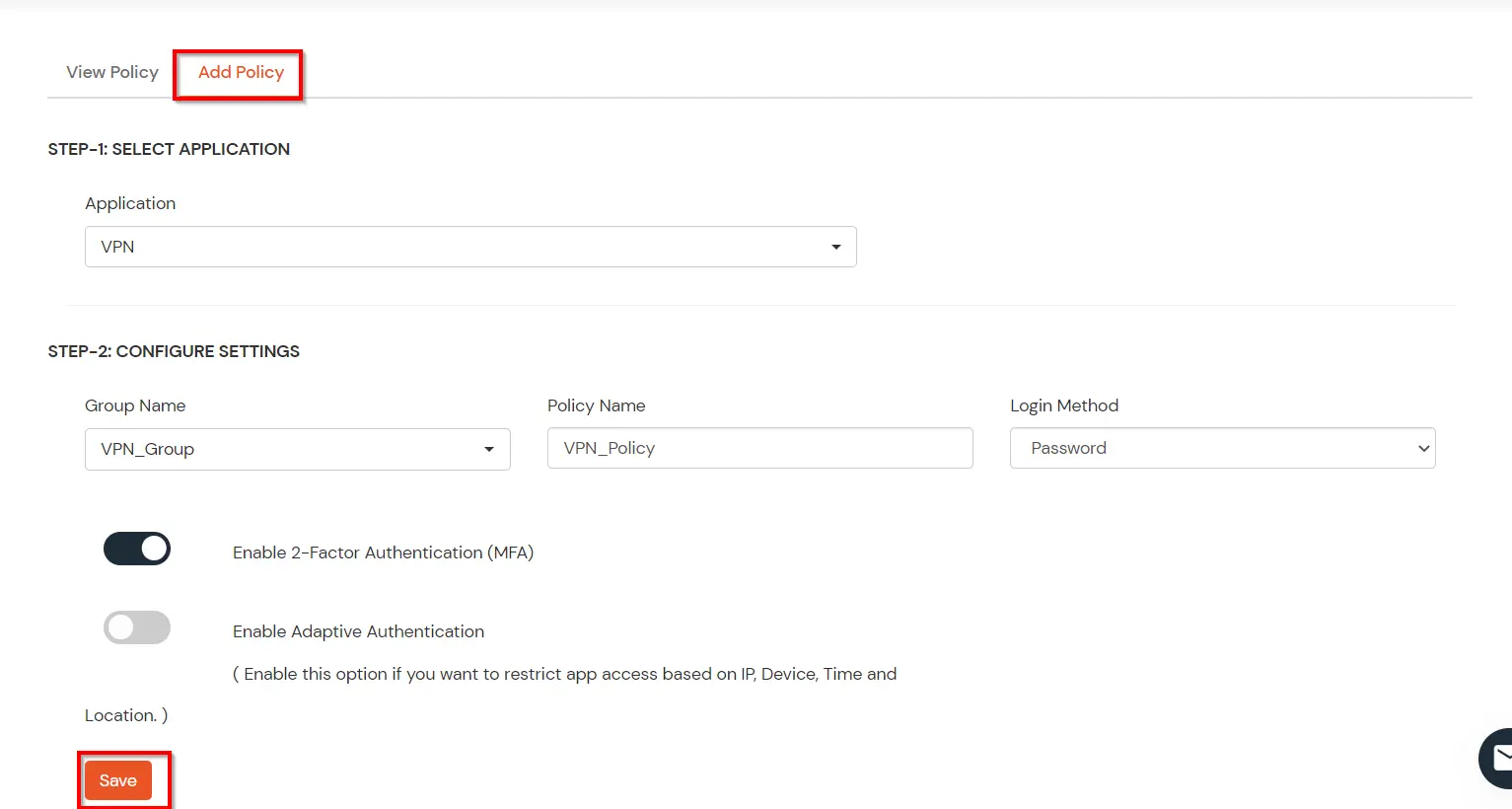
10. Test miniOrange 2FA setup for Sophos UTM VPN Login
- Right-Click the VPN icon and select "Connect"
- Login with the same Username and Password.
- You will be prompted to enter your OTP. Enter this in the dialog box that appears.
- Verify your connection by seeing if the tray icon went from Red to Green.



11. Troubleshooting
Further References
- Why one should secure their VPN?
- Adaptive Multi-Factor authentication
- Two-Factor Authentication for Open VPN
- How 2FA helps to secure VPN?
Source: https://www.miniorange.com/two-factor-authentication-for-sophos
0 Response to "Java Sophos Utm Api Example"
Post a Comment